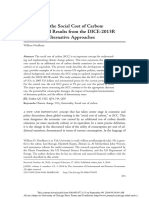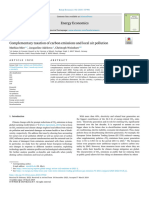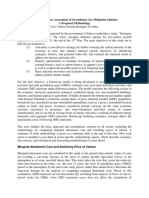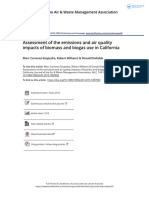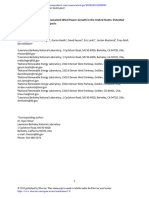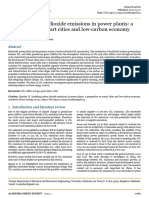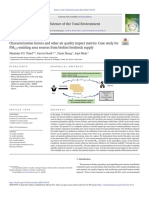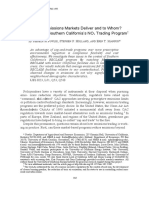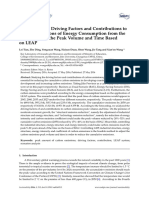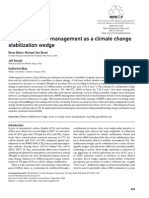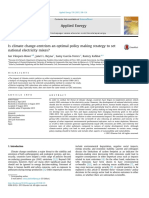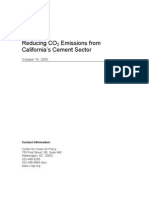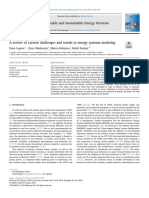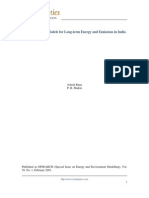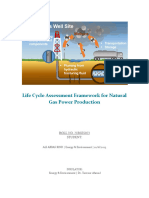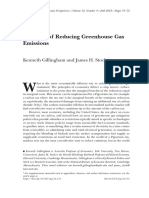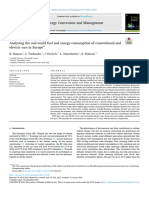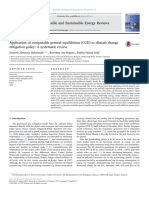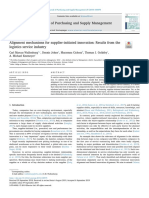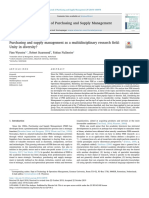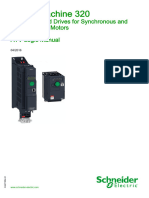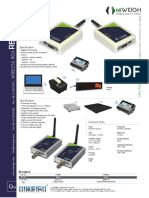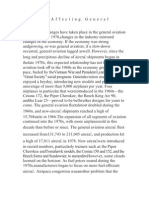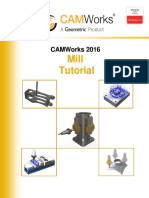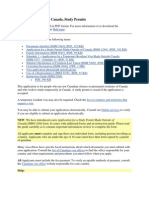Estimating Criteria Pollutant
Estimating Criteria Pollutant
Uploaded by
Sunita ChayalCopyright:
Available Formats
Estimating Criteria Pollutant
Estimating Criteria Pollutant
Uploaded by
Sunita ChayalOriginal Title
Copyright
Available Formats
Share this document
Did you find this document useful?
Is this content inappropriate?
Copyright:
Available Formats
Estimating Criteria Pollutant
Estimating Criteria Pollutant
Uploaded by
Sunita ChayalCopyright:
Available Formats
Geosci. Model Dev.
, 11, 1293–1320, 2018
https://doi.org/10.5194/gmd-11-1293-2018
© Author(s) 2018. This work is distributed under
the Creative Commons Attribution 4.0 License.
Estimating criteria pollutant emissions using the California Regional
Multisector Air Quality Emissions (CA-REMARQUE) model v1.0
Christina B. Zapata1 , Chris Yang2 , Sonia Yeh2 , Joan Ogden2 , and Michael J. Kleeman1
1 Department of Civil and Environmental Engineering, University of California – Davis, Davis, California, USA
2 Institute of Transportation Studies, University of California – Davis, Davis, California, USA
Correspondence: Michael J. Kleeman (mjkleeman@ucdavis.edu)
Received: 16 July 2017 – Discussion started: 8 August 2017
Revised: 24 January 2018 – Accepted: 26 January 2018 – Published: 11 April 2018
Abstract. The California Regional Multisector Air Quality size fractions of primary particulate matter. Primary PM2.5
Emissions (CA-REMARQUE) model is developed to predict emissions decrease by 4 % in the GHG-Step scenario vs. the
changes to criteria pollutant emissions inventories in Cal- BAU scenario while corresponding primary PM0.1 emissions
ifornia in response to sophisticated emissions control pro- decrease by 36 %. Ultrafine particles (PM0.1 ) are an emerg-
grams implemented to achieve deep greenhouse gas (GHG) ing pollutant of concern expected to impact public health in
emissions reductions. Two scenarios for the year 2050 act as future scenarios. The complexity of this situation illustrates
the starting point for calculations: a business-as-usual (BAU) the need for realistic treatment of criteria pollutant emissions
scenario and an 80 % GHG reduction (GHG-Step) scenario. inventories linked to GHG emissions policies designed for
Each of these scenarios was developed with an energy eco- fully developed countries and states with strict existing envi-
nomic model to optimize costs across the entire California ronmental regulations.
economy and so they include changes in activity, fuels, and
technology across economic sectors. Separate algorithms are
developed to estimate emissions of criteria pollutants (or
their precursors) that are consistent with the future GHG sce- 1 Introduction
narios for the following economic sectors: (i) on-road, (ii)
rail and off-road, (iii) marine and aviation, (iv) residential Many countries around the world are debating cost-effective
and commercial, (v) electricity generation, and (vi) biore- candidate strategies to mitigate threats to long-term prosper-
fineries. Properly accounting for new technologies involving ity including climate change and threats to public health.
electrification, biofuels, and hydrogen plays a central role These specific issues are at least partially linked through re-
in these calculations. Critically, criteria pollutant emissions gional air quality. Realistic mitigation plans for greenhouse
do not decrease uniformly across all sectors of the econ- gas (GHG) emissions (CO2 , CH4 , N2 O, etc.) usually in-
omy. Emissions of certain criteria pollutants (or their pre- clude measures encouraging reduced energy consumption or
cursors) increase in some sectors as part of the overall opti- changes to energy sources leading to reduced GHG emis-
mization within each of the scenarios. This produces nonuni- sions. These measures also impact emissions of criteria pol-
form changes to criteria pollutant emissions in close proxim- lutants or their precursors (particulate matter (PM), NOx ,
ity to heavily populated regions when viewed at 4 km spa- SOx , volatile organic compounds (VOCs), NH3 , etc.) that
tial resolution with implications for exposure to air pollution influence regional air quality. Air quality influences pub-
for those populations. As a further complication, changing lic health through impacts on mortality (primarily related to
fuels and technology also modify the composition of reac- PM2.5 ) and morbidity (primarily related to PM2.5 and O3 ).
tive organic gas emissions and the size and composition of Many previous attempts to characterize the impact of cli-
particulate matter emissions. This is most notably apparent mate policies on criteria pollutant emissions, air quality, and
through a comparison of emissions reductions for different public health have often emphasized countries where poten-
tial health savings are largest. These previous studies have
Published by Copernicus Publications on behalf of the European Geosciences Union.
1294 C. B. Zapata et al.: Estimating criteria pollutant emissions using the CA-REMARQUE model v1.0
also usually performed calculations for large geographic ar- calculations start with energy scenarios developed by the en-
eas without resolving details at regional scales appropriate ergy economic model CA-TIMES. The details needed to pro-
for California (Bollen et al., 2009; Garcia-Menendez et al., duce criteria pollutant emissions inventories are discussed in
2015; Rafaj et al., 2012; Shindell et al., 2012; van Aardenne the following sections.
et al., 2010; West et al., 2013). These studies represent Cal-
ifornia with only a small number of grid cells or they use 2.1 CA-TIMES energy model and energy scenarios
simplistic representations of California’s energy economy.
More recent studies addressing interactions between cli- CA-TIMES (McCollum et al., 2012; Yang et al., 2014,
mate policies, emissions, and air quality in the US (Ke- 2015) is a bottom-up energy–economic model originally
shavarzmohammadian et al., 2017; Loughlin et al., 2011; based on the TIMES (The Integrated MARKAL-EFOM Sys-
Ran et al., 2015; Rudokas et al., 2015; Trail et al., 2015; tem) model (Loulou et al., 2016). CA-TIMES is a cost-
Zhang et al., 2016) have allocated future emissions using en- minimization optimization model that balances energy sup-
hanced population surrogates (Ran et al., 2015) and federal ply and demand system-wide from all energy sectors of
climate policies (Trail et al., 2015). The current study builds the economy. Demand includes the transportation, industrial,
on this previous work to explicitly account for California’s residential, commercial, and agricultural sectors. Fuel and
ambitious climate regulations broken down into detailed sec- electricity supply includes electric, biofuel, hydrogen pro-
tors including realistic siting of biofuel facilities. The cur- duction plants, and biofuel and petroleum refineries. De-
rent study also considers the effects of regenerative braking mand was assumed fixed for the scenarios considered (Yang
and exhaust particulate size and speciation changes from the et al., 2014, 2015). CA-TIMES allows imports from out of
heavy use of alternative and renewable fuels across multiple state, such as oil, natural gas, and electricity. Renewables
economic sectors. These enhancements support the desired and biomass are handled separately and modeled explicitly
level of detailed analysis for the intersection of air, climate, as located in or out of state and imports are determined on
and energy choices in California. a cost basis. CA-TIMES contains capital and operation costs
The purpose of this paper is to describe the Cali- for each technology and diverse fuel and energy carriers, and
fornia Regional Multisector Air Quality Emissions (CA- it calculates GHG emissions for CO2 , CH4 , and N2 O.
REMARQUE) model that can translate complex GHG miti- The case studies considered in the present study focus on
gation scenarios into criteria pollutant emissions inventories two CA-TIMES scenarios in 2050: (i) a business-as-usual
with sufficient detail to support fine-scale air quality mod- (BAU) scenario that achieves the goals outlined in Califor-
els and public health analysis. Here we emphasize solutions nia Assembly Bill 32 (AB32), the Global Warming Solu-
that optimize statewide total GHG emissions across the entire tions Act of 2006 and (ii) a climate-friendly GHG-Step sce-
California economy, with potential trade-offs between differ- nario that achieves an 80 % reduction (relative to 1990 level)
ent source types to achieve this objective. The complex opti- in GHG emissions by 2050. Statewide GHG emissions un-
mization problem requires an energy economic model and so der each scenario are summarized in Fig. 1. In the GHG-
we focus on scenarios predicted by the CA-TIMES energy Step scenario a “step” GHG emissions constraint in which
economic model as the starting point for the analysis. The a constant 2020 cap is held until 2050 is applied, and then an
detailed algorithms within the CA-REMARQUE model are 80 % reduction is applied from 2050 onward. This allows the
then developed to translate predicted changes in GHG emis- model freedom to adopt strategies that lower GHG emissions
sions associated with source activity, fuels, and technology prior to 2049 if those strategies minimize costs. This 2050
into criteria pollutant emissions that are spatially resolved GHG constraint causes aggressive change over the period
(4 km) for each sector of the California economy. Changing 2040–2049 but does not shock to the energy system in 2050
emissions profiles caused by fuel substitutions are also ac- because the CA-TIMES model has perfect foresight and op-
counted for. Final results are compared to an expert-analysis timally minimizes the energy system cost (with a 4 % dis-
method developed for a previous global analysis to illustrate count factor) over the entire period from 2010 to 2050, mak-
why the complex methods described in this study are needed ing investment decisions to meet targets. Also, CA-TIMES
when analyzing developed regions like California that have investments in low-GHG technologies start slowly and grow
major diversified economies and a long history of environ- to reach the required market share to meet the targets since
mental regulations. technologies have finite lifetimes and cannot take over re-
spective markets instantaneously. The criteria pollutant emis-
sions between 2010 and 2049 were not analyzed in the cur-
2 Methodology rent study but a summary of CA-TIMES results for inter-
mediate years is provided by Yang et al. (2015). Both BAU
Energy scenarios are translated to criteria pollutant emissions and GHG-Step scenarios include current and sunset GHG
inventories by the CA-REMARQUE model in a multistep regulations in California: Corporate Average Fuel Economy
process with unique algorithms developed for each major (CAFE) standards (California Air Resources Board, 2005,
sector of the economy that emits air pollution precursors. All 2009b, 2010b), the Zero Emission Vehicle (ZEV) mandate
Geosci. Model Dev., 11, 1293–1320, 2018 www.geosci-model-dev.net/11/1293/2018/
C. B. Zapata et al.: Estimating criteria pollutant emissions using the CA-REMARQUE model v1.0 1295
to extrapolate further to 2050. In the second step, an inter-
mediate 4 km vehicular emissions inventory was generated
by combining EMFAC 2050 projections with a 2010 4 km
emissions inventory as a spatial surrogate. In the third step,
the 2050 fossil fuel vehicular emissions rates that were pro-
jected from EMFAC as well as new emissions rates gathered
from alternative fuel emissions literature were used to scale
the 4 km intermediate mobile emissions inventory based on
the vehicle miles traveled (VMTs), trips, and vehicle class
and (conventional and alternative) fuel consumption output
produced for each CA-TIMES scenario.
2.2.1 EMFAC emissions and activity projections
Figure 1. Greenhouse gas emissions in California under the BAU Criteria pollutant emissions for on-road mobile sources in
and GHG-Step scenarios. future years were forecast using the EMFAC 2011 model
developed by the California Air Resources Board (CARB)
(California Air Resources Board, 2011a). EMFAC 2011 ac-
(California Air Resources Board, 2012b, c, d, e, f), Low Car- counts for annual VMT trends and vehicle fleet composi-
bon Fuel Standard (LCFS) (California Air Resources Board, tion turnover using Department of Motor Vehicles (DMV)
2009c, 2011c), Cap-and-Trade Program (California Air Re- data. EMFAC incorporates the latest on-road mobile poli-
sources Board, 2011d, 2017), and federal and state incentives cies including the Low-Emission Vehicle emissions stan-
(tax credits and subsidies). CA-TIMES predicts total annual dards, LCFS, Pavley Clean Car Standard, and the Truck and
energy consumption in California for the year 2050 to be Bus ruling (California Air Resources Board, 2011a). EMFAC
8763 PJ in the BAU scenario and 7679 PJ in the GHG-Step 2011 predicts past, present, and future year (up to 2035 or
scenario (reference value for 2010 is approximately 7500 PJ) 2040) emissions including anticipated future emissions stan-
(Yang et al., 2015). dards and regulations specific to California. EMFAC predicts
The methods to estimate criteria emissions for different emissions and energy activity (VMT, trips, vehicles, gallons
sources developed in the current paper take advantage of the of fuel) for 69 geographical area indexes (GAIs) which rep-
best available information describing future energy and emis- resent the intersection of air basins and counties (listed in
sions as a function of location. The quality of this informa- Table S1 in the Supplement).
tion varied considerably for each major source category and In the current study, EMFAC was run for each calendar
so the details of the methodology also varied. Figure 2 illus- year from 2020 to 2035 to infer the emissions trends that
trates an overview of the general procedure. The changes in could then be extrapolated to 2050. A simple linear regres-
energy consumption and GHG emissions produced by CA- sion model was used to represent VMT over the period 2020–
TIMES for each energy sector in the year 2050 were trans- 2035, while a logarithmic regression model was fit to pollu-
lated into changes in criteria pollutant emissions by account- tant emissions for each vehicle type over the same time pe-
ing for changing energy activity levels or fuel switching. riod. Future studies will use EMFAC 2014, which directly
Literature searches were conducted to identify any previ- predicts emissions in 2050, making this step unnecessary.
ous studies describing spatial locations of future emissions
within California. Altered emissions for the year 2050 were 2.2.2 Spatial allocation of mobile source emissions in
then projected from a 2010 emissions inventory with 4 km an intermediate 2050 inventory
spatial resolution provided by the California Air Resources
Board (CARB). Additional details for each major source type An existing on-road mobile emissions inventory for the year
are discussed below. 2010 with 4 km spatial resolution served as the starting point
for the projection of an intermediate emissions inventory in
2.2 CA-REMARQUE on-road mobile algorithms 2050. Scaling factors to account for VMT growth and adop-
tion of existing policies were first calculated as the ratios
On-road mobile sources include passenger cars, light-duty between EMFAC emissions from 2010 and (extrapolated)
trucks (LDTs), medium-duty trucks (MDTs), heavy-duty 2050 within each of the 69 GAI regions. Separate scaling
trucks (HDTs), buses, motorcycles, and motor homes. On- factors were developed for each pollutant emitted from dif-
road emissions were generated in a multistep process sum- ferent vehicle classes and control technologies as represented
marized in Fig. 3. In the first step, 2010–2035 emissions by unique emissions inventory codes (EICs). The combined
projection trends from the Emission Factor (EMFAC) 2011 intermediate emissions (em) scaling factor SFact + met de-
model (California Air Resources Board, 2011a) were used fined in Eq. (3) reflects independent changes in activity (act)
www.geosci-model-dev.net/11/1293/2018/ Geosci. Model Dev., 11, 1293–1320, 2018
1296 C. B. Zapata et al.: Estimating criteria pollutant emissions using the CA-REMARQUE model v1.0
Figure 2. Process diagram of emissions inventory generation for each sector or mode.
(Eq. 1) and meteorology (met) (Eq. 2). Future 2054 tem- 2.2.3 CA-TIMES modification of intermediate 2050
perature and relative humidity generated at 4 km resolution on-road mobile emissions
with WRF3.2 (Zhang et al., 2014) were averaged to GAI
regions used by EMFAC to produce hour-specific reactive
organic gas (ROG) emissions rates that vary from the an-
Statewide CA-TIMES scaling factors were applied to the
nual average emissions rates. Activity is either defined as
2050 intermediate emissions inventory described in the pre-
VMTs or vehicle trips, depending on the emissions pro-
vious section uniformly at all locations to produce the fi-
cess. For example, activity equals VMT for tailpipe emis-
nal 2050 emissions inventory. EMFAC accounts for popu-
sions rates (e.g., g NO mile−1 ) or tire- and brake-wear emis-
lation growth and emissions changes that are required by
sions (g PM mile−1 ). Otherwise, activity equals the number
existing air quality rules and regulations through 2050. CA-
of vehicles within each type, fuel, and aftertreatment cate-
TIMES accounts for additional changes that will be required
gory such as for evaporative emissions of non-methane hy-
to comply with state GHG targets but which have not yet
drocarbons (g NMHC vehicle−1 ) from the fuel system (non-
been placed into emissions rules and regulations. The final
tailpipe emissions). Emissions rates are highly dependent on
inventory retains the spatial and temporal features inherent
the emissions process (evaporative, exhaust, tire or brake
in the intermediate emissions inventory but incorporates up-
wear), fuel (gasoline or diesel), and the aftertreatment device
dated information about new fuels, technologies, and emis-
(catalytic or non-catalytic).
sions rates based on statewide predictions from CA-TIMES
Emissions within each 4 km grid cell of the 2010 inventory
(Fig. 4).
are multiplied by the 2050 to 2010 scaling factor SFact+met to
EMFAC vehicle classes expressed as EIC codes were
estimate the “intermediate” 2050 emissions that will be fur-
mapped to compatible vehicle classes used by CA-TIMES
ther modified according to various additional policy choices
as described in Table S2 in the Supplement. Spark igni-
represented in CA-TIMES.
tion (gasoline) vehicles in CA-TIMES were further clas-
sified as catalyst equipped or non-catalyst equipped to
match EMFAC categories. EMFAC resolves non-catalyst-
em(act2050 , met2010 )
SFact = (1) equipped and catalyst-equipped gasoline vehicles into sev-
em(act2010 , met2010 ) eral sub-categories (light-heavy-duty truck and heavy-heavy-
em(act2010 , met2050 ) duty truck; see Table S2 in the Supplement for complete de-
SFmet = (2)
em(act2010 , met2010 ) scription of vehicle classes) while CA-TIMES does not in-
SFact+met = SFact · SFmet (3) clude this level of resolution.
Geosci. Model Dev., 11, 1293–1320, 2018 www.geosci-model-dev.net/11/1293/2018/
C. B. Zapata et al.: Estimating criteria pollutant emissions using the CA-REMARQUE model v1.0 1297
Figure 3. Simplified sequence of algorithms, calculations, and inputs used in developing the CA-TIMES alternative fuel on-road mobile
emissions inventory per scenario. EIC is emissions inventory code.
The use of new fuels in the on-road fleet required special VMT associated with the conventional fuel divided by the
consideration during preparation of the 2050 emissions in- energy content of the consumed conventional fuel (Ev ) mul-
ventory. As a starting point, emissions rates from EICs repre- tiplied by the energy content of the alternative fuel (Ev, f )
senting conventionally fueled vehicles were calculated from output by CA-TIMES. This calculation assumes that vehi-
2050 EMFAC output by dividing each pollutant emissions cle weight and aerodynamics do not change significantly as
by the respective vehicle activity indicator (either VMT, ve- alternative fuels are adopted. Finally, the emissions rate for
hicle number, or fuel consumption) to serve as a baseline each alternative fuel was estimated based on a literature re-
for CA-TIMES scenario adjustments. Next, the 181 combi- view of emissions factors for conventionally vs. alternatively
nations of alternative fuels and electric hybrid, dedicated or fueled vehicles. Reference emissions rates (erv, ref ) and alter-
single/multi-fueled applications, and vehicle weight classes native to conventional scaling factors (erv, f /erv, ref ) for the
were mapped to EMFAC by vehicle class and reference fuel vehicle fuels of interest are listed in Table 1.
(see Tables S2 and S3 in the Supplement). CA-TIMES pre- Equation (4) illustrates how the total emissions (emv ) were
dicts the amount of alternative fuel consumed, not the VMT calculated for a given vehicle class (subscript v) by summing
associated with that alternative fuel. The VMT associated the product of the emissions rate and VMT for each fuel (sub-
with each alternative fuel was therefore estimated as the script f) for the number of different fuels (n) consumed by
www.geosci-model-dev.net/11/1293/2018/ Geosci. Model Dev., 11, 1293–1320, 2018
1298 C. B. Zapata et al.: Estimating criteria pollutant emissions using the CA-REMARQUE model v1.0
1000
900
800
Energy consumption (PJ)
700
600
500
400
300
200
100
0
CAR LDT MDT HDT MOT BUS CAR LDT MDT HDT MOT BUS CAR LDT MDT HDT MOT BUS
2010 2050 BAU 2050 GHG-step
Hydrogen 0.0 0.0 0.0 0.0 0.0 0.0 21.9 11.8 0.0 0.0 0.0 0.0 159.4 71.6 0.0 0.0 0.0 0.0
Electricity 0.0 0.0 0.0 0.0 0.0 0.4 0.0 0.0 0.0 0.0 0.0 0.0 108.8 38.2 15.2 0.0 0.0 1.5
Biodiesel 0.0 0.0 0.0 0.0 0.0 0.8 0.0 0.0 0.0 0.0 0.0 12.8 6.9 0.0 0.0 227.8 0.0 19.9
E85 0.0 0.0 0.0 0.0 0.0 0.0 98.3 288.0 0.0 0.0 0.0 0.0 0.0 0.0 0.0 0.0 0.0 0.0
Natural gas 0.0 0.0 0.0 0.0 0.0 21.2 0.0 0.0 254.4 0.0 0.0 52.9 0.0 0.0 94.5 0.0 0.0 0.0
Diesel 1.4 0.3 198.4 291.4 0.0 19.1 0.0 0.0 0.0 564.2 0.0 0.0 0.0 0.0 0.0 142.3 0.0 0.1
Gasoline 835 921 124 1.5 5.2 11.7 574.7 502.3 172.4 18.7 7.2 16.1 4.1 10.0 131.7 0.0 5.4 9.1
Figure 4. CA-TIMES energy consumption by vehicle weight class, fuel, and scenario for on-road sources. Vehicle categories include car,
light-duty truck (LDT), medium-duty truck (MDT), heavy-duty truck (HDT), motorcycles (MOT), and bus.
Figure 5. Particle emissions size and composition distribution for catalyst-equipped gasoline vehicles (a) and catalyst-equipped ethanol
(E85) vehicles (b).
that vehicle as defined by each CA-TIMES scenario. where v is vehicle type by weight; f is unconventional or al-
n ternative fuel type from f1 , f2 , f3 . . .n; ref is reference (con-
X erv, f Ev, f
emv = erv, ref · · actv · , (4) ventional) fuel, typically gasoline or diesel; emv is emissions
f |
erv, ref Ev (t per day) of ROG, CO, NOx , PM10 , and SOx for a given
{z } | {z }
Alternative Proportion of vehicle type; erv, ref is pollutant emissions rate for a vehi-
fuel/energy activity by cle using the reference (conventional) fuel based from EM-
emissions rate fuel/energy FAC (t of pollutant VMT−1 or t of pollutant vehicle−1 ); erv, f
for vehicle is pollutant emissions rate for a vehicle using an alternative
Geosci. Model Dev., 11, 1293–1320, 2018 www.geosci-model-dev.net/11/1293/2018/
C. B. Zapata et al.: Estimating criteria pollutant emissions using the CA-REMARQUE model v1.0 1299
Figure 6. Particle emissions size and composition distribution for diesel vehicles (a), biodiesel vehicles (b), and CNG catalyst-equipped
vehicles (c).
Figure 7. Particle emissions size and composition distribution for jet-fueled aircraft (a) and biomass-based kerosene jet-fueled aircraft (b).
fuel based from EMFAC (t of pollutant VMT−1 or t of pol- Tables S4 to S12 in the Supplement) were actually used in
lutant vehicle−1 ); actv is total vehicular activity (not divided the 2050 BAU and GHG-Step scenarios as the model was
by fuel) (VMT or vehicles); ev, f is energy consumption for optimized for low-cost and low-carbon solutions. The main
a given fuel by vehicle given by CA-TIMES scenario (PJ); alternative liquid or gaseous fuels projected by CA-TIMES
and ev is total energy consumed for vehicle for all fuels by were E85, biodiesel, and CNG. CA-TIMES predicted that
CA-TIMES scenario (PJ). E85 would displace gasoline while biodiesel and CNG would
Alternative fuels considered by CA-TIMES include 95 % displace diesel based on the dominant fuel consumed for the
volume blend methanol (M95), 85 % volume blend ethanol same vehicle weight class counterpart. This fuel substitution
(E85), compressed natural gas (CNG), liquid petroleum gas alters emissions rates for criteria pollutants as shown in Ta-
(LPG), biodiesel, compressed or liquid hydrogen, and elec- ble 1. For battery electric or fuel cell vehicles, the conven-
tric drivetrains. Electric vehicles include hybrid, plug-in hy- tional fuel displaced was based on the dominant fuel for that
brid, and plug-in or battery hybrid. CA-TIMES often selected vehicle class, e.g., gasoline for LDVs.
the use of multiple technologies and fuels within the same
vehicle weight class (see Tables S4 through Table S12 in the 2.2.4 On-road mobile particulate matter and gas
Supplement for complete lists). For example, in the case of speciation and size profile changes
a hybrid diesel–electric vehicle which runs on three energy
sources, diesel, biodiesel, and electricity (e.g., a biodiesel
Tailpipe exhaust, fuel-tank evaporative, and brake-wear
plug-in hybrid MDT), three sets of emissions rates (one for
emissions were adjusted when the vehicle fuel or technol-
each fuel) were estimated to replace the single emissions rate
ogy was changed. This requires new source profiles to be
for the traditional compression ignition (CI) engine for this
defined for E85-, biodiesel-, and CNG-fueled vehicles to
vehicle class (diesel MDT).
describe their emissions of speciated VOCs and size- and
Only approximately 10 % of the possible vehicle type–
composition-resolved PM. New EICs were created (summa-
fuel–engine combinations considered by CA-TIMES (see
rized in Table S13 in the Supplement) and associated with
www.geosci-model-dev.net/11/1293/2018/ Geosci. Model Dev., 11, 1293–1320, 2018
1300 C. B. Zapata et al.: Estimating criteria pollutant emissions using the CA-REMARQUE model v1.0
Figure 8. Particle emissions size and composition distribution for ships powered by marine residual oil (a), marine biodiesel (b), and
biomass-based residual fuel oil (c).
new VOC and PM emissions profiles (summarized in Ta- Dynamometer Drive Schedules (UDDS) driving cycle (Yoon
bles S14 – S16) for this purpose. et al., 2014) (see Table S16 in the Supplement). Figure 6 il-
Multiple measurements are available in the literature for lustrates the size and composition distribution of PM emit-
the composition of exhaust from ethanol-fueled vehicles. In ted from diesel vehicles, biodiesel vehicles equipped with
the present study, the average VOC profiles measured using a diesel particle filter and exhaust gas recirculation, and
the Federal Test Procedure, Unified Cycle, and US06 high- catalyst-equipped CNG vehicles.
speed drive cycles were used for the hot-running E85 VOC All fully electric vehicles, such as battery electric vehicles
exhaust (Haskew and Liberty, 2011). The Federal Test Proce- and H2 fuel cell vehicles, were assumed to have zero tailpipe
dure phase 1 profile was applied for the cold-start E85 VOC exhaust and evaporative emissions rates. Brake-wear emis-
emissions (Haskew and Liberty, 2011). E85 PM size distribu- sions rates were reduced by 59 % (Antanaitis, 2010) for all
tions are summarized in Table S15 in the Supplement (Szy- partial or fully electric vehicles equipped with regenerative
bist et al., 2011) while PM composition information is sum- breaking, such as hybrid, electric battery, or fuel cell vehi-
marized in Table S16 in the Supplement (Ferreira da Silva cles. Tire-wear emissions were assumed to be independent
et al., 2010; Hays et al., 2013). Figure 5 illustrates the size of fuel or technology type.
and composition distribution of PM emitted from catalyst-
equipped gasoline vehicles and catalyst-equipped vehicles 2.3 CA-REMARQUE aviation, rail, and off-road
fueled by 85 % ethanol and 15 % gasoline (E85) as an ex- algorithms
ample.
Aftertreatment devices were found to be more influential Aviation sources include commercial, civil, agricultural, or
on biofuel exhaust rates (Alleman et al., 2005; Alleman et al., military use and primarily run on jet fuel or aviation gaso-
2004; Frank et al., 2007; Hasegawa et al., 2007; Rounce line. The rail emissions sources include passenger, com-
et al., 2012; Tsujimura et al., 2007) than changes to fuel prop- muter, switching, and hauling trains, which currently run pri-
erties and feedstock origin (Durbin et al., 2007; Graboski marily on diesel-fueled generators powering an electric driv-
et al., 2003). Diesel particulate filters, exhaust gas recircu- etrain. Off-road equipment includes industrial, agricultural,
lation, selective catalytic reduction, and oxidation catalyst and construction equipment; port and rail operations; and
(OC) were assumed to be deployed on diesel- and biodiesel- lawn and garden equipment. The list of aviation, rail, and
powered vehicles by 2050. PM size distributions for vehi- off-road emissions source categorizations are based on the
cles equipped with diesel particle filters were obtained from EICs listed in Table S17 in the Supplement (including new
Rounce et al. (2012) (Table S15 in the Supplement), and EICs created to represent sources operating on alternative fu-
trace element, carbonaceous, and inorganic ion fractions of els previously not in the CARB inventory).
PM distributions were obtained from Cheung et al. (2010)
and Cheung et al. (2009) (see Table S16 in the Supplement). 2.3.1 VISION model
Gas-phase VOC emissions profiles for biodiesel were not up-
Future 2050 emissions for aviation, rail, and off-road equip-
dated from fossil diesel profiles in the current study, but this
ment were assumed to follow the 2010 vs. 2050 growth
change will be considered in future work.
projected by the CARB VISION model (California Air
The CNG VOC profile and PM size distribution was con-
Resources Board, 2012a), an off-road expansion of Ar-
structed based on Gautam (2011) (Tables S14 and S15).
gonne’s on-road VISION model (Argonne National Lab-
PM emissions of carbonaceous compounds, metals, and ions
oratory Transportation Technology R&D Center, 2012).
were measured from CNG vehicles running on the Urban
CARB’s off-road VISION model uses historical trends to
Geosci. Model Dev., 11, 1293–1320, 2018 www.geosci-model-dev.net/11/1293/2018/
C. B. Zapata et al.: Estimating criteria pollutant emissions using the CA-REMARQUE model v1.0 1301
Table 1. Emissions rate changes for alternative fuels in on-road vehicles. Alternative fuels include an 85 % ethanol and 15 % gasoline
mixture (E85), biodiesel (B100), and compressed natural gas. Conventional fuels include gasoline, diesel, or ultra-low-sulfur diesel (USLD).
Aftertreatment devices include a three-way catalyst (TWC), a diesel oxidation catalyst (DOC), a diesel particle filter (DPF), exhaust gas
recirculation ( EGR), and selective catalytic reduction (SCR).
Alternative Reference After- Pollutant Alt/ Conv Data source
fuel conventional treatment conv %
ratio change
fuel
E85 Gasoline Same CO 1.00 0.0 % Graham et al. (2008)
(TWC)
NOx 0.55 −45 % Graham et al. (2008)
SOx 1.00 0.0 % Assumed
ROG 1.00 0.0 % Graham et al. (2008)
PM 0.25 −75 % Hays et al. (2013)
B100 Diesel or DOC+ CO 0.03 −97 % Alleman et al. (2004),
ULSD DPF+ Alleman et al. (2005),
EGR+ Hasegawa et al. (2007)
SCR
NOx 0.85 −15 % Alleman et al. (2004),
Alleman et al. (2005),
Tsujimura et al. (2007)
SOx 1.00 0.0 % Assumed
ROG 0.03 −97 % Alleman et al. (2004),
Alleman et al. (2005),
Hasegawa et al. (2007)
PM 0.03 −97 % Alleman et al. (2004),
Alleman et al. (2005),
Hasegawa et al. (2007),
Rounce et al. (2012)
CNG Diesel or TWC CO 0.67 −33 % Cooper et al. (2012)
ULSD
NOx 0.19 −81 % Cooper et al. (2012)
SOx 1.00 0.0 % Assumed
ROG 0.34 −66 % Cooper et al. (2012)
PM 0.08 −92 % Cooper et al. (2012)
project to the year 2050 while incorporating some future mate prior to CA-TIMES adjustments using Eq. (5).
standards for criteria pollutant emissions rates. These include 2050
!
em
the implementation of Tier 4 130–560 kW compression- em2050
cell, i, intermediate =
i
· em2010
cell, i , (5)
ignition diesel engine emissions standards for PM, CO, and em2010
i
NMHC + NOx (California Air Resources Board, 2010a),
| {z }
leading to 90 % reduction in PM emissions rates and an 85 % Statewide
reduction in NMHC and NOx emissions rates. emissions growth
Aviation, rail, and off-road 2010 emissions at 4 km reso- scaling from
lution (em2010 2010 to 2015
cell,I ) were scaled to produce an intermediate esti-
where em2050
cell, i, intermediate is intermediate grid cell 2050 emis-
sions for a transport source (aviation, rail, off-road) con-
suming a reference or conventional fuel or energy (kg h−1 ),
www.geosci-model-dev.net/11/1293/2018/ Geosci. Model Dev., 11, 1293–1320, 2018
1302 C. B. Zapata et al.: Estimating criteria pollutant emissions using the CA-REMARQUE model v1.0
em2050
i is statewide 2050 emissions of a transport source conventional diesel emissions) of 0.39 and 1.08, respectively
(kg h−1 or t day−1 ), em2010
i is statewide 2010 emissions of (Durbin et al., 2007). No significant changes in CO, SOx and
a transport source (kg h−1 or t day−1 ), and em2010
cell, i is grid PM due to the adoption of biodiesel vs. ULSD were identi-
cell 2010 emissions of a transport source (kg h−1 ). fied in the literature and so these emissions were assumed
to remain at levels estimated for conventional diesel en-
2.3.2 CA-TIMES modification of intermediate 2050 gines. This approach inherently assumes that the sulfur con-
off-road mobile emissions tent of biodiesel will not exceed the current limit of 15 ppm
for ULSD. Off-road or agricultural emissions changes from
The portion of energy consumed for each fuel (Ei, f /6f Ei, f ) switching from diesel to CNG are also found to have large re-
as projected by CA-TIMES was applied to the intermedi- ductions in most pollutants except for ROGs (Cooper et al.,
ate 2050 emissions inventory for each transport mode (f) 2012).
and source type (i) using Eq. (6). The consumption of dif- Military aviation emissions were held constant at 2010
ferent fuels relative to total fuel consumption for a given levels in the current study due to an assumption of contin-
mode is shown in Figs. S1–S3 for rail, off-road, and avia- ued exemptions for military activity.
tion modes, respectively. Alternatives to conventional scaling
factors were applied to account for the adoption of alternative 2.3.3 Off-road mobile PM and gas speciation and size
fuels as summarized in Table 2. Equation (6) also includes an profile changes
aftertreatment or control device factor (1 − η) where appro-
priate. PM mass size distributions for E85, biodiesel, and CNG are
! assumed to be similar for off-road and on-road vehicles (Ta-
Ei, f em2050
i, f ble S15 in the Supplement). The new PM mass size distribu-
SFi, f = P · · (1 − ηi ), (6)
Ei, f em2050
i, intermediate
| {z } tion for biomass-based KJF is shown in Table S18 in the Sup-
f Fraction of
| {z } plement (Lobo et al., 2011). Figure 7 illustrates the size and
Alternative fuel
| {z }
pollutant not
Portion of emissions scaling removed by composition distribution of PM emitted from conventional
alternative relative to aftertreatment jet-fuel aircraft and biomass-based KJF aircraft. The conven-
fuel energy conventional device
consumption tional profile is based on old source profile measurements
that assumed uniform distribution of particles between the
where SFi, f is the emissions scaling factor for a given new
diameters of 0.1 and 1.0 µm. This conventional profile will
or alternative or nonconventional or non-reference fuel for
be updated with more recent literature values in future work.
a transport source (dimensionless), Ei, f is new or alterna-
tive fuel or energy consumed byPa transport source (e.g., 2.4 CA-REMARQUE marine algorithms
biodiesel for commuter rail) (PJ), f Ei, f is total fuel or en-
ergy consumed by a transport source (e.g., biodiesel + diesel The marine emissions source category includes all ocean-
for commuter rail) (PJ), em2050i, f is statewide 2050 emissions going vessels (OGVs), commercial harbor craft, and recre-
of a transport source consuming a new or alternative fuel ational boats (see Table S19 in the Supplement). An interme-
(kg h−1 or t day−1 ), em2050
i, intermediate is statewide 2050 inter- diate OGV emissions inventory was predicted for the year
mediate emissions of a transport source consuming a new or 2050 based on the extrapolation of Port of Los Angeles and
alternative fuel (kg h−1 or t day−1 ), and ηi is efficiency of re- Port of Long Beach 2020 trends (Starcrest Consulting Group,
moval from a control or aftertreatment device (fraction from 2009; The Port of Los Angeles and The Port of Long Beach,
0.00 to 1.00). 2010) (see Table S20 in the Supplement). All other OGV
The final emissions for each specific off-road source con- emissions (not listed in Table S20 in the Supplement) in Cal-
suming each specific fuel in 2050 (em2050 cell, i, f ) are then cal- ifornia were held constant at 2010 levels in the intermediate
culated by combining the effects of the VISION and CA- 2050 inventory prior to modifications from CA-TIMES.
TIMES updates as shown in Eq. (7).
em2050 2050 2.4.1 CA-TIMES modification of intermediate 2050
cell, i, f = SFi, f · emcell, i, intermediate (7)
marine emissions
Aviation biomass-based kerosene jet fuel (KJF) emissions
changes are based on Fischer–Tropsch gas-to-liquid biofuel The fuels used to power OGVs were modified based on pre-
aviation emissions tests (Lobo et al., 2011, 2012). These dictions from the CA-TIMES scenarios. It should be noted
studies found minor changes to CO and NOx emissions due that the CA-TIMES model reports worldwide marine energy
to the adoption of biofuels. SOx reduction was assumed pro- consumption. In the current study, it was assumed that ma-
portional to the fuel sulfur content (Lobo et al., 2012), lead- rine vessels operating near the California coast would con-
ing to reductions of 99 % as shown in Table 2. sume the global average mix of biofuels produced by CA-
Off-road equipment (other than trains) operating on TIMES. For example, if CA-TIMES indicated that a third
biodiesel instead of ultra-low-sulfur diesel (ULSD) was as- of the residual fuel oil (RFO) (also call heavy fuel oil) con-
sumed to emit HC and NOx with scaling factors (relative to sumed globally by marine vessels was converted to biomass-
Geosci. Model Dev., 11, 1293–1320, 2018 www.geosci-model-dev.net/11/1293/2018/
C. B. Zapata et al.: Estimating criteria pollutant emissions using the CA-REMARQUE model v1.0 1303
Table 2. Emissions rate changes for alternative fuels in off-road vehicles.
Transport Alternative Reference Pollutant Alt/ Conv Citations
mode fuel conven- conv %
tional ratio change
fuel
Rail Biodiesel Diesel CO 0.655 −34.5 % Osborne et al. (2010)
NOx 1.13 13 % Osborne et al. (2010)
SOx 0.0005 −99.95 % Assumed (see text)
ROG 0.775 −22.5 % Osborne et al. (2010)
PM 0.805 −19.5 % Osborne et al. (2010)
Off-road/ Biodiesel Diesel CO 1 0% Durbin et al. (2007)
agricultural
NOx 1.08 8% Durbin et al. (2007)
SOx 1 0% Durbin et al. (2007)
ROG 0.39 −61 % Assumed (see text)
PM 1.13 13 % Durbin et al. (2007)
Compressed Diesel CO 0.668 −33.2 % Cooper et al. (2012)
natural gas
NOx 0.189 −81.1 % Cooper et al. (2012)
SOx 1 0% Assumed (see text)
ROG 2.349 134.9 % Cooper et al. (2012)
PM 0.0782 −92.18 % Cooper et al. (2012)
Aviation Biomass- Kerosene CO 1 0% Lobo et al. (2012)
based jet fuel
kerosene
jet fuel
NOx 1 0% Lobo et al. (2012)
SOx 0.007 −99.3 % Assumed (see text)
ROG 0.605 −39.5 % Lobo et al. (2012)
PM 0.38 −62 % Lobo et al. (2011)
based residual fuel oil (BRFO) in the future, then a third of regulated pollutant observed to remain constant during emis-
the RFO marine vessel emissions near California boundaries sions testing. Emissions of all other pollutants decreased as
would also be converted to BRFO. As indicated by Fig. S4 summarized in Table 3.
in the Supplement, CA-TIMES finds that other approaches Assuming biodiesel and BRFO has about 1 ppm of sulfur
in addition to biofuel adoption for ships are more cost ef- content, and that by 2010 the sulfur content regulations en-
fective for meeting the GHG target in 2050. CA-TIMES de- sured that marine diesel oil (MDO) and RFO had 1.5 ppm
termined that it will be more economical to substitute some and 2.5 ppm of S, respectively, then the switch to biofuels
RFO with a lighter petroleum (diesel) to decrease carbon in- would reduce SOx emissions by 33.3 % (relative to conven-
tensity rather than using BRFO. tional MDO) and 60 % (relative to conventional RFO). Ad-
Alternative fuels used in marine sources will modify cri- ditional reductions in CO, total organic gas (TOG), and PM
teria pollutant emissions. Biomass-based alternatives for ma- were also projected based on Jayaram et al. (2011) and Pet-
rine RFO were estimated to be similar to the average of B100 zold et al. (2011) as summarized in Table 3.
from palm oil, animal fat, soybean oil, and sunflower oil op- Several international and California shoreline regulations
erating at 75 % load (Petzold et al., 2011). NOx was the only were applied to marine emissions in the year 2050 as summa-
www.geosci-model-dev.net/11/1293/2018/ Geosci. Model Dev., 11, 1293–1320, 2018
1304 C. B. Zapata et al.: Estimating criteria pollutant emissions using the CA-REMARQUE model v1.0
Table 3. Emissions rate changes from ships changing from conventional fuels to biofuels.
Alternative Reference Pollutant Alt/ Conv Citations
fuel conventional conv %
ratio change
fuel
Biomass- Residual CO 0.697 −30.3 % Petzold et al. (2011)
based fuel
residual fuel oil
oil
NOx 1 0% Petzold et al. (2011)
SOx 0.012 −98.8 % Petzold et al. (2011)
ROG 0.413 −58.7 % Petzold et al. (2011)
PM 0.223 −77.7 % Petzold et al. (2011)
Biodiesel Diesel CO 0.921 −7.9 % Jayaram et al. (2011)
NOx 1 0% Jayaram et al. (2011)
SOx 0.0003 −99.97 % Assumed (see text).
ROG 1 0% Jayaram et al. (2011)
PM 0.684 −31.6 % Jayaram et al. (2011)
rized in Tables S21 and S22. At-berth or hotelling container, (Table S24 in the Supplement) (State of California, 2013)
passenger (cruise), and refrigeration OGVs will use shoreline to produce an intermediate emissions inventory. These inter-
power instead of auxiliary engines for 80 % of their berthing mediate residential and commercial gridded emissions were
hours by 2020 (California Air Resources Board, 2007). It then scaled to reflect 2010 vs. 2050 results from CA-TIMES
was also assumed that MDO or marine gasoline oil used (Fig. 9).
within 24 nautical miles of the California shore will have a Natural gas consumption in the commercial sector was re-
sulfur content of < 0.1 % by 2050 (California Air Resources duced by half (325 to 162 PJ) in the GHG-Step scenario rela-
Board, 2011e). Further offshore, all marine fuels used within tive to the BAU scenario in 2050. Most of commercial energy
100 nautical miles of North America were assumed to have reduction is due to efficiency gains and switch from natu-
a sulfur content < 1 % after the year 2012 (leading to the re- ral gas to electrification of end uses. Natural gas consump-
ductions shown in Table 3). tion in the residential sector also decreases (615 to 507 PJ)
under the GHG-Step scenario relative to the BAU scenario.
2.4.2 Marine PM and gas speciation and size profile Much of the energy that would have been supplied by natural
changes gas is replaced by renewable sources such as solar (155 PJ),
which was assumed to have no criteria pollutant emissions in
PM size distribution changes caused by the switch to alter- California. Improved energy efficiency and conservation also
native marine fuels were based on Jayaram et al. (2011) (see plays a role, with residential electricity consumption decreas-
Table S23 in the Supplement). The size and composition dis- ing (402 to 313 PJ) in the GHG-Step scenario. Other combus-
tribution profiles used to represent marine emissions associ- tion sources, including wood burning and distillate oil fuel
ated with different fuels are displayed in Fig. 8. consumption, were allowed to compete in CA-TIMES sub-
ject to the constraint that they could not increase above the
2.5 CA-REMARQUE residential and commercial
2010 levels in order to maintain compliance with current air
algorithms
quality regulations.
Major emissions sources within the residential and com-
mercial sectors include natural gas combustion (space heat- 2.6 CA-REMARQUE electricity generation algorithms
ing and water heating), biomass combustion (fireplaces and
stoves), and food cooking (especially charbroiling and fry- The electricity generation emissions category includes all
ing). The residential and commercial emissions associated fuel-burning and renewable power plants for industrial, resi-
with natural gas and food cooking were assumed to scale dential, commercial, or transportational use. Annual genera-
according to population growth projected for each county tion totals for different types of California power plants were
Geosci. Model Dev., 11, 1293–1320, 2018 www.geosci-model-dev.net/11/1293/2018/
C. B. Zapata et al.: Estimating criteria pollutant emissions using the CA-REMARQUE model v1.0 1305
1200
1000
Energy consumption (PJ)
800
Natural gas Solar
600 Natural gas
Natural gas Natural gas
400 Natural gas Natural gas
200 Electricity Electricity Electricity Electricity
Electricity Electricity
-
2050 GHG- 2050 GHG-
2010 2050 BAU 2010 2050 BAU
step step
Commercial Residential
Solar - - 155
Wood 20 - -
Liquid petroleum gas - - - 19 77 76
Natural gas 289 325 162 507 615 224
Electricity 398 361 355 313 402 307
Figure 9. CA-TIMES energy consumption by energy resource and scenario for commercial and residential use.
extracted from national power plant data (US Energy Infor- eration by energy source for each SWITCH region averaged
mation Administration Independent Statistics and Analysis, across these 15 scenarios. This profile of resource potential
2012; US Environmental Protection Agency, 2014). Emis- was then applied to the CA-TIMES predictions summarized
sions rates per unit of fuel burned were estimated for each in Table S25 in the Supplement yielding the 2050 and 2010
power plant described in the base case 2010 emissions in- scaling factors for the BAU scenario (Table S27 in the Sup-
ventory. plement) and the GHG-Step scenario (Table S28 in the Sup-
CA-TIMES finds that non-hydro renewable (geother- plement).
mal, tidal, solar, wind, and biomass) increases from 10 % The scaling factors summarized in Tables S27 and S28 as-
(22 938 GWh) of the electricity generation mix in 2010 sume that the out-of-state portion of electricity generation for
(144 825 GWh) to 35 and 76 % (489 493 GWh) in the a given fuel or energy resource in the year 2050 remained
2050 BAU and 2050 GHG-Step scenarios, respectively (see constant at 2010 levels. CA-TIMES does not provide addi-
Fig. 10). However, total in-state and out-of-state electricity tional information describing out-of-state generation except
generation in the GHG-Step scenario is one-third larger than for a few renewables. This out-of-state portion of the elec-
the BAU scenario (416 219 GWh vs. 643 373 GWh) to meet tricity generation was subtracted from the CA-TIMES totals
the increased demand from sectors such as the on-road ve- prior to scaling emissions from each power plant in Califor-
hicles with growing hybridization and electrification needed nia. Table S29 in the Supplement summarizes the out-of-state
to meet the 2050 carbon constraint. Statewide scaling fac- portion of electricity generation for each fuel in 2010 and as-
tors for electricity generation in the 2050 BAU scenario vs. sumed portions in each of the 2050 scenarios.
2010 and the 2050 GHG-Step scenario vs. 2010 are listed in Additional emissions adjustments were made for new re-
Table S25 in the Supplement. newable fuels such as those produced by the biomass inte-
CA-TIMES calculates aggregated statewide energy totals grated gasification combined cycle (IGCC), a process that
but energy resources (especially for renewables) are not uni- gasifies biomass for electricity production. Much of the
formly distributed across the state. In the current study, re- biomass electricity generation projected by CA-TIMES for
newable electricity production in 2050 was spatially allo- 2050 in the BAU scenario uses biomass IGCC (see Ta-
cated in a manner that was consistent with the energy re- bles S30 through S32). There are currently several coal IGCC
source potential in 12 regions (Fig. S5 in the Supplement) as plants in the US (US Department of Energy National En-
projected in 15 scenarios by the grid load distribution model ergy Technology Laboratory, 2010, 2015) but no biomass
SWITCH (Fripp, 2012; Johnston et al., 2013; Nelson et al., IGCC plants (Lundqvist, 1993; Ståhl and Neergaard, 1998;
2013). Table S26 in the Supplement lists the electrical gen- US Department of Energy National Energy Technology Lab-
www.geosci-model-dev.net/11/1293/2018/ Geosci. Model Dev., 11, 1293–1320, 2018
1306 C. B. Zapata et al.: Estimating criteria pollutant emissions using the CA-REMARQUE model v1.0
Electricity generation
7.0E+02
6.0E+02
Wind
5.0E+02
Electricity generation (TWh)
4.0E+02 Biomass
Wind
Solar
3.0E+02
Hydro
Geothermal
2.0E+02 Hydro
Nuclear Hydro
Geothermal
Natural gas
1.0E+02
Natural gas
Natural gas
0.0E+00
2010 2050 BAU 2050 GHG-step
Figure 10. CA-TIMES electricity generation resource mix by scenario.
oratory, 2010). Future biomass IGCC emissions in Califor- include farming livestock, crops, food production, bakeries,
nia were estimated using several models that incorporate and breweries. Most of these industries were unchanged in
biomass IGCC, such as GREET, CA-GREET (Argonne Na- the CA-TIMES energy scenarios, with the notable exception
tional Laboratory Transportation Technology R&D Center, that biofuel and hydrogen fuel production replaced some tra-
2014; California Air Resources Board, 2009a, 2015), and a ditional petroleum production, causing changes in refinery
National Renewable Energy Laboratory analysis (Mann and and storage emissions (shown in Figs. S6–S8).
Spath, 1997). Ultimately, biomass IGCC power plant emis-
sions were estimated from conversion of conventional steam 2.7.1 Fossil and renewable fuel production
turbines in the 2010 CARB inventory based on emissions
rates inferred from CA-GREET1.8 for 2050 (Table S33 in the All fossil petroleum refining and storage emissions in the
Supplement). An inter-comparison study among GREET1.8, 2010 Air Resources Board emissions inventory were scaled
GREET 2014, and CA-GREET2.0 showed that the CA- according to the amount of oil production and refining that
GREET1.8b model had the best agreement with emissions was required in California for each 2050 CA-TIMES sce-
rates from approximately 30 biomass plants operating on nario (see Fig. S6 in the Supplement). Scaling factors were
wood residue in California (California Air Resources Board, applied uniformly to all emissions processes including seep-
2011b; US Environmental Protection Agency, 2014). age, evaporative or fugitive, and other processes. Fossil
petroleum consumption generally decreased in future scenar-
2.7 CA-REMARQUE industrial and agricultural ios, but was not eliminated. As discussed in previous sec-
algorithms tions, transportation modes (e.g., marine, HDTs) still con-
sume fossil fuels such as diesel, and the stationary sources
The industrial and agricultural emissions category covers (electricity generation, residential, and commercial) still con-
many manufacturing industries such as metal, wood, glass, sume natural gas. CA-TIMES determined that much of the
textiles, mining, and chemicals. Food and agricultural sectors extracted petroleum used by refineries would be imported to
Geosci. Model Dev., 11, 1293–1320, 2018 www.geosci-model-dev.net/11/1293/2018/
C. B. Zapata et al.: Estimating criteria pollutant emissions using the CA-REMARQUE model v1.0 1307
the state rather than extracted locally. This can be seen by 2.7.2 Biogas capture and use
the reduction of crude oil supply in California from 1510 PJ
in 2010 to 426.5 PJ in the 2050 BAU scenario and 0.0 PJ in CA-TIMES assumes that landfill gas reduces over time due
the GHG-Step scenario (see Fig. S6 in the Supplement). Re- to better management of organic matter in landfills and
fining is also projected to decline slightly between the 2010 the consumption of existing landfill stock material over
and 2050 scenarios, with reductions of 25 % in the BAU sce- many decades. All biogas in CA-TIMES is converted to
nario and 44 % in the GHG-Step scenario. This suggests that biomethane through removal of CO2 and impurities and fur-
it is more cost effective or less carbon intensive to import fuel ther blended with natural gas so that it is undistinguishable
than to extract oil and gas in or around California. The total from extracted fossil natural gas.
(imported and in-state) oil supply also decreases in 2050, by Dairy biogas is a significant renewable energy source in
−26 % in the BAU (3200 PJ) and −44 % in the GHG-Step CA-TIMES. California produced a fifth of the milk in the
scenario (2400 PJ) relative to 2010 (4300 PJ). This reflects US in 2010 (California Department of Food and Agricul-
the adoption of electrification and alternative fuels to replace ture, 2011) and an exponential regression using 2001–2013
petroleum consumption in the presence of growing energy CFDA data estimates the number of dairy cows in Cali-
demand in 2050. fornia may increase by a factor of 1.5 by the year 2050.
Hydrogen (H2 ) production increased in both 2050 CA- Methane emissions rates were estimated from GHG inven-
TIMES scenario results, but the increases in the GHG-Step tory documentation (California Air Resources Board, 2014)
scenario are much larger (Fig. S7 in the Supplement). It for each manure management practice: liquid/slurry, anaer-
was assumed that new hydrogen production facilities would obic lagoon, anaerobic digester, daily spread, deep pit, pas-
be located at current H2 production facilities or existing re- ture, and solid storage. The increase in the cow population
fineries. Overall 32 new natural gas steam methane reform- was assumed to occur uniformly across all management prac-
ing (SMR) H2 facilities and 15 new biomass gasification fa- tices except for the systems used in biogas capture. These
cilities were projected to meet the demand summarized in systems, including anaerobic digester, anaerobic lagoon, and
Fig. S7 in the Supplement. In the current study, criteria pollu- liquid/slurry management practices, were adjusted to meet
tant emissions rates from SMR H2 production (summarized the quantities of biogas specified by each CA-TIMES sce-
in Table 4) were calculated from the top three SMR H2 pro- nario. The amount of waste produced by each dairy cow each
duction facilities (California Air Resources Board, 2010c, year was used to estimate the annual biomethane production
2014). Few studies have been published describing crite- and energy potential of each animal. The electricity poten-
ria pollutant emissions from biomass gasification H2 pro- tial from biomethane is then calculated using AgSTAR con-
duction and so emissions rates for this production pathway version rates (Environmental Protection Agency, 2010; US
were obtained from the CA-GREET model (California Air Environmental Protection Agency AgSTAR Program, 2011).
Resources Board, 2015). Direct criteria pollutant emissions The overall fugitive VOC emissions from animal waste de-
from hydrogen production using electrolysis were zero since clines in the biogas production scenarios since a large frac-
this process uses electricity to split water molecules into H2 tion of the waste is treated. Overall, fugitive dairy manure
and oxygen (emissions from these facilities appear under VOC emissions increased by 50 % due to cow population
electricity generation). growth in the BAU scenario and decreased by 33 % for the
The CA-TIMES model determined that biofuel consump- GHG-Step scenario relative to 2010.
tion and production will be high in California in the year Future biomethane production sites were selected based on
2050 (Fig. S8 in the Supplement). Biofuel refineries for dif- recommendations from the USDA’s Cooperative Approaches
ferent feedstock classes (wood, municipal solid waste, herba- for Implementation of Dairy Manure Digesters (US De-
ceous crops, yellow grease or tallow, or corn ethanol) (see partment of Agriculture Rural Development Agency, 2009).
Tables S34 and S35) were located using a spatial biomass Mainly, locations were selected with nearby pipeline net-
optimization model which seeks to minimize cost within re- works (Gilbreath et al., 2014) to transport raw biogas to
source and regulatory constraints (Tittmann et al., 2010). a centralized cleanup facility, where it can then be com-
Biofuel refineries were prohibited in NAAQS non-attainment pressed and sold for use by electric generation power plants
areas, an added constraint based on the high feedstock case or as transportation fuels. This was considered a more viable
described by Parker (2012). Production rates at in-state biore- option as natural gas pipeline infrastructure is easy to access,
fineries were scaled to match the in-state volumes produced demand from electric utilities for biomethane is high to meet
in CA-TIMES for each type of biofuel. Out-of-state imports the renewable portfolio standard, and a centralized cleanup
and refining were assumed for crops that could not be grown facility is more economical than distributed facilities.
at a large enough scale to meet the demand in California,
such as herbaceous crops and the bulk of corn ethanol (see
Tables S34 and S35). Emissions for each biofuel refinery
were estimated using CA-GREET1.8b emissions rates per
unit of fuel produced.
www.geosci-model-dev.net/11/1293/2018/ Geosci. Model Dev., 11, 1293–1320, 2018
1308 C. B. Zapata et al.: Estimating criteria pollutant emissions using the CA-REMARQUE model v1.0
Table 4. Pollutant emissions rate associated with hydrogen production. Units are micrograms of pollutant per kilojoule of hydrogen produced.
SMR – average of Gasification – CA- Electrolysis
top CA H2 SMR GREET 2015 gasification
facilities vs. SMR scaling
CO 4.079 0.997 0
NOx 1.612 0.34 0
SOx 0.087 0.406 0
VOC 2.208 1.118 0
PM10 0.410 0.048 0
3 Results and discussion exceed tailpipe emissions (Fig. 12) in both the 2050 BAU
and GHG-Step scenarios due to the adoption of increasingly
3.1 On-road mobile emissions clean vehicle technology. Tailpipe emissions in the GHG-
Step scenario are a factor of ∼ 1.8 lower than tailpipe emis-
Figure 11 illustrates PM emissions of tire and brake wear sions in the BAU scenario. In contrast, tire- and brake-wear
from on-road vehicles under the BAU and GHG-Step sce- emissions are predicted to decrease by a factor of +3 under
narios. The fine spatial distribution of the emissions reflects the GHG-Step scenario. This reflects the fact that BAU gaso-
the spatial distribution of tire- and brake-wear emissions in line and diesel tailpipe emissions already incorporate signif-
the base 2010 inventory that is updated using EMFAC pre- icant emissions control technology yielding fewer opportu-
dictions to produce the intermediate 2050 emissions inven- nities for further improvement. Tire- and brake-wear emis-
tory. The technology changes inherent in the CA-TIMES sions have almost no control technology in the BAU scenario,
BAU and GHG-Step scenarios are then applied uniformly which makes the widespread adoption of electric or hybrid
across the state, yielding virtually identical spatial distribu- drivetrains using regenerative braking particularly effective
tions for the final 2050 BAU and GHG-Step scenario emis- at reducing emissions.
sions. Tire- and brake-wear emissions patterns illustrated in The current analysis assumes that no new major highways
Fig. 11 essentially follow predicted vehicle activity patterns will be built in California and population growth is accom-
in the state. Predicted emissions are highest in major urban modated partially through increased urban density such that
centers and along major transportation corridors. Although traffic volumes increase uniformly across the transportation
increase in vehicular activity was part of this study, expan- network. These assumptions are simplistic but a previous
sion of roadways between 2010 and 2050 was not consid- study of smart growth in the San Joaquin Valley indicated
ered in this study and may be updated in newer versions of that more detailed accounting of population growth had min-
the model. imal impact on air quality (Hixson et al., 2010).
California’s environmental regulations apply uniformly
across the state, which supports the assumption of uniform 3.2 Rail and off-road emissions
GHG emissions reductions for on-road vehicles. Despite the
uniform regulatory landscape, some of the measures de- PM emissions from off-road and rail sources are plotted in
scribed in the CA-TIMES GHG-Step scenario rely on mod- Fig. 13 for the BAU and GHG-Step scenarios examined in
ified behavioral patterns and willingness or ability to adopt the current study. Maximum statewide PM emissions for
new technologies, which may change by region. Education this source category are centered at the location of major
levels, personal wealth, and environmental attitudes vary construction projects with lower emissions rates for “rou-
sharply across California. Capturing these trends in subre- tine” off-road emissions distributed more broadly according
gions of the state will require surveys of consumer choice to typical activity patterns for smaller construction projects,
and predictions of future behavior that are beyond the scope rail, etc. The 2010 emissions inventory that acts as the ba-
of the current paper. sis for the 2050 projections in the current project correctly
Figure 12 illustrates the PM emissions from tailpipe ex- identified replacement of the east span of the Bay Bridge
haust under the 2050 BAU scenario and the 2050 GHG-Step in the San Francisco Bay Area as the leading construction
scenario. Similar to the tire- and brake-wear emissions, the project with the highest overall emissions in the state. This
spatial pattern for mobile sources is identical under both sce- ∼USD 6.5 billion project spanned more than 10 years, with
narios because the technology changes specified by the CA- the new bridge completed in 2013 and final decommissioning
TIMES model are applied uniformly over the entire state. and demolition of the old eastern span scheduled for 2018.
Tailpipe PM emissions once again follow patterns of vehi- It is difficult to predict the location of major construc-
cle activity as predicted by EMFAC. Of greater interest is the tion projects in 2050 but it is reasonable to expect that sev-
prediction that tire- and brake-wear emissions (Fig. 11) will eral large projects will be active in that timeframe. Candi-
Geosci. Model Dev., 11, 1293–1320, 2018 www.geosci-model-dev.net/11/1293/2018/
C. B. Zapata et al.: Estimating criteria pollutant emissions using the CA-REMARQUE model v1.0 1309
(a) 2050 BAU (μg -2 m min-1 ) (b) 2050 GHG-step minus BAU
(μg m-2 min-1)
Central/
northern
CA
domain
Southern
CA
domain
Figure 11. Particulate matter emissions from vehicle tire and break wear in the BAU scenario (a) and emissions change in the GHG-Step
scenario (b). Units are µg m−2 min−1 .
(a) 2050 BAU (μg -2 m min-1 ) (b) 2050 GHG-step minus BAU
(μg m-2 min-1)
Central/
northern
CA
domain
Southern
CA
domain
Figure 12. Particulate matter emissions of vehicle tailpipe exhaust in the BAU scenario (a) and emissions change in the GHG-Step scenario
(b). Units are µg m−2 min−1 .
date projects currently under discussion include additional tants that would affect air quality over major urban centers. In
replacement of California’s numerous highways and bridges, the present study, the peak emissions associated with the ma-
upgrading California’s water conveyance systems to better jor construction project around the Bay Bridge were retained
withstand earthquakes, development of high-speed rail lines, in the future scenario as an example of a major construc-
reinforcement or expansion of seawalls to protect property, tion project near an urban area. Future model analysis that
etc. Each of these projects will potentially emit criteria pollu- uses these emissions should conduct sensitivity tests to en-
www.geosci-model-dev.net/11/1293/2018/ Geosci. Model Dev., 11, 1293–1320, 2018
1310 C. B. Zapata et al.: Estimating criteria pollutant emissions using the CA-REMARQUE model v1.0
(a) 2050 BAU (μg -2 m min-1 ) (b) 2050 GHG-step minus BAU
(μg m-2 min-1)
Central/
northern
CA
domain
Southern
CA
domain
Figure 13. Particulate matter emissions from rail and other off-road sources in the BAU scenario (a) and emissions change in the GHG-Step
scenario (b). Units are µg m−2 min−1 .
sure that the assumed placement of this example major con- sions vs. the benefits of the decreased on-road emissions will
struction project does not influence the overall conclusions be considered in future studies that include analysis with re-
of the study. gional air quality models.
Maximum PM emissions shown in Fig. 13 decrease by
a factor of approximately 1.64 in the GHG-Step scenario rel- 3.4 Residential and commercial emissions
ative to the BAU scenario. Adoption of biomass-based fuels
was also found to reduce emissions of SOx , HC, PM, and oc- Figure 15 illustrates PM emissions from residential and com-
casionally CO from off-road and rail sources, but NOx emis- mercial sources under the 2050 BAU and GHG-Step sce-
sions increased for some fuel choices. narios. The spatial patterns of emissions largely follow the
estimated population projections in California in the year
3.3 Marine and aviation emissions 2050 as summarized in Table S24 in the Supplement. Pop-
ulation growth was assumed to be identical under the BAU
PM emissions from marine and aviation sources are shown and GHG-Step scenarios yielding virtually identical spatial
in Fig. 14 for the BAU and GHG-Step scenarios considered distributions for both scenarios. The adoption of new tech-
in the present study. The highest PM emissions rates occur nologies and altered behavioral patterns predicted by the CA-
in offshore shipping lanes that converge on the Port of Los TIMES model under the GHG-Step scenario were applied
Angeles, the Port of Long Beach, and the Port of Oakland. uniformly over the state without modification by income, ed-
Emissions rates change with proximity to California shores ucation level, or regional differences in environmental atti-
due to regulations governing sulfur content of marine fuel tudes. Predicted changes to PM emissions from residential
or ship speed. Emissions patterns at inland locations reflect and commercial sources are modest with slight reductions
shipping activity on inland waterways or activity surrounding of ∼ 10 % mostly attributed to energy efficiency measures.
small regional airports. Widespread adoption of biomethane to replace natural gas is
Maximum PM emissions rates from marine sources in- predicted in the GHG-Step scenario but this fuel change has
crease under the GHG-Step scenario as illustrated most little impact on criteria pollutant emissions.
clearly in the right panels of Fig. 14. CA-TIMES determined
that the available biofuel capacity could be more efficiently
used to offset traditional fossil fuels for on-road transporta-
tion sources and so the GHG-Step scenario is predicted to
incorporate additional fossil fuels for marine sources under
the GHG-Step scenario vs. the BAU scenario. The net re-
sult of the disbenefits associated with increased marine emis-
Geosci. Model Dev., 11, 1293–1320, 2018 www.geosci-model-dev.net/11/1293/2018/
C. B. Zapata et al.: Estimating criteria pollutant emissions using the CA-REMARQUE model v1.0 1311
(a) 2050 BAU (μg -2 m min-1 ) (b) 2050 GHG-step minus BAU
(μg m-2 min-1)
Central/
northern
CA
domain
Southern
CA
domain
Figure 14. Particulate matter emissions from marine and aviation sources in the BAU scenario (a) and emissions change in the GHG-Step
scenario (b). Units are µg m−2 min−1 .
(a) 2050 BAU (μg -2 m min-1 ) (b) 2050 GHG-step minus BAU
(μg m-2 min-1)
Central/
northern
CA
domain
Southern
CA
domain
Figure 15. Particulate matter emissions from residential and commercial sources in the BAU scenario (a) and emissions change in the
GHG-Step scenario (b). Units are µg m−2 min−1 .
3.5 Electricity generation emissions tions typically powered by natural gas in the BAU scenario.
The majority of the colored grid cells in Fig. 16 are asso-
Figure 16 illustrates predicted emissions of PM from com- ciated with smaller backup generators that operate intermit-
bustion processes used to generate electricity. These emis- tently and therefore have very low emissions. These backup
sions are represented as point sources and so only the grid units are typically powered by a fossil fuel such as diesel fuel
cells containing an electrical generation unit are colored. The in the BAU scenario, with a shift to biofuels in the GHG-Step
highest emissions rates for individual grid cells are associ-
ated with a small number of major electrical generation sta-
www.geosci-model-dev.net/11/1293/2018/ Geosci. Model Dev., 11, 1293–1320, 2018
1312 C. B. Zapata et al.: Estimating criteria pollutant emissions using the CA-REMARQUE model v1.0
(a) 2050 BAU (μg -2 m min-1 ) (b) 2050 GHG-step minus BAU
(μg m-2 min-1)
Central/
northern
CA
domain
Southern
CA
domain
Fi 16 P i l i i f l i i i ( i i 6) i h BAU
Figure 16. Particulate matter emissions from electricity generation (emissions source category type 6) in the BAU scenario (a) and emissions
change in the GHG-Step scenario (b). Units are µg m−2 min−1 .
scenario. This fuel switch has a modest impact on total emis- practice, biorefineries were generally sited near landfills or
sions given the low utilization of these units. industrial or agricultural areas within each city selected as
Peak emissions rates of PM decrease by a factor of ∼ 1.7 economically optimal within the specified constraints. The
in the GHG-Step scenario primarily due to a reduction in enforcement of NAAQS constraints on biorefineries led to
fossil fuel electricity generation in favor of a shift to so- a smaller number of larger refineries under both the BAU and
lar and wind sources (see Fig. 10). All generating stations GHG-Step scenarios. Note that overall biorefining output is
are assumed to continue operation at a reduced rate in the higher in the BAU scenario than in the GHG-Step scenario.
GHG-Step scenario rather than selectively decommissioning Biofuels have lower associated GHG emissions than tradi-
some stations. The age and efficiency of existing natural- tional fossil fuels but their carbon intensity is still too high
gas-generating stations will likely be key factors determining to meet the GHG emissions target represented in the GHG-
how they are operated in the future scenarios. Solar and wind Step scenario. The CA-TIMES model therefore predicts that
electricity generation does not emit criteria pollutants and so a portion of the energy supplied by biofuels in the BAU sce-
the location of these facilities is not shown in Fig. 16. nario will instead be supplied by wind and solar in the GHG-
Step scenario.
3.6 Biorefinery emissions
3.7 Summary of statewide emissions
Figure 17 shows the locations of refineries producing bio-
fuels (biorefineries) in California under the BAU and GHG- Figure 18a illustrates the net change in emissions related to
Step scenarios considered in the present study. The location criteria pollutants in California in the GHG-Step scenario vs.
of future biorefineries was chosen to minimize transportation the BAU scenario analyzed in the current study. Emissions
costs for the raw materials feeding into the refinery and the of each pollutant are broken down by the major emissions
delivery of fuel to the final point of end use. Additional zon- categories analyzed in Sect. 2. The miscellaneous category is
ing constraints were considered to prevent the placement of equivalent in the BAU and GHG-Step scenarios and hence is
biorefineries near schools, hospitals, or other locations with not plotted. Contributions below 0 % indicate emissions re-
sensitive populations. More generally, a constraint was con- ductions, while contributions above 0 % indicate emissions
sidered to restrict the placement of new biorefineries in re- increases. Each of these changes represents the statewide av-
gions that currently violate the NAAQS. The top panels of erage for the sources within the indicated sector. Note that
Fig. 11 therefore do not allow the placement of biorefineries the changes within each sector may not be uniform across
in either the San Joaquin Valley or the South Coast Air Basin the entire state. The net change in total emissions is indi-
(SoCAB), while the less constrained scenarios illustrated in cated by the black horizontal line for each species. It is im-
the lower panels of Fig. 17 do not impose this restriction. In mediately apparent that the emissions reductions illustrated
Geosci. Model Dev., 11, 1293–1320, 2018 www.geosci-model-dev.net/11/1293/2018/
C. B. Zapata et al.: Estimating criteria pollutant emissions using the CA-REMARQUE model v1.0 1313
(a) BAU scenario (b) GHG-step scenario
With air quality non-attainment constraint
(d)
Without air quality non-attainment constraint
(c)
Figure 17. Biorefinery locations under the BAU scenario (a) and the GHG-Step scenario (b). Legend shows PM2.5 mass emissions rates
per facility (µg m−2 min−1 ). Panels (a) and (b) represent the constrained case in which biorefineries cannot be located in air basins out of
compliance with National Ambient Air Quality Standards (NAAQS). Panels (c) and (d) are not constrained by NAAQS status.
in Fig. 18a are not uniform for all pollutants. Maximum re- to differences in the response of primary PM with aerody-
ductions of ∼ 60 % are observed for CO2 and particulate namic diameter less than 2.5 µm (PM2.5 ) and less than 0.1 µm
copper (Cu) emissions. In contrast, emissions of particulate (PM0.1 ; ultrafine particles). Ultrafine particles are an emerg-
SO2−4 , gaseous CO, and gaseous SOx actually increase under ing pollutant of concern expected to influence public health
the GHG-Step scenario due to trade-offs in the technologies (Delfino et al., 2005; Hoek et al., 2010; Knol et al., 2009).
adopted in the off-road mobile categories (rail, marine, avi- The results shown in Fig. 18a illustrate that the GHG-Step
ation, etc.) needed to optimize the overall GHG emissions scenario leads to only a 4 % decrease in primary PM2.5 emis-
across the state. Emissions of pollutants that experience in- sions but a much larger 36 % reduction in PM0.1 emissions.
creasing trends in Fig. 18a are minor in the present-day in- Recent epidemiology results indicate that PM0.1 is associated
ventory and so they do not currently trigger NAAQS viola- with mortality in the California Teachers Study (Ostro et al.,
tions. Changes in key highly emitted pollutants fall in be- 2015). Likewise, toxicology studies indicate that ultrafine
tween the extreme cases described above (see results for par- particles are more toxic than larger particles per unit mass
ticulate elemental carbon (EC), particulate OC, and gaseous (Donaldson et al., 2001, 2002; Elder et al., 2006; Kreyling
NOx ). Each of these pollutants experiences a net decrease et al., 2004; Oberdorster et al., 2002). Enhanced PM0.1 emis-
in total emissions averaged across California, but emissions sions reductions could amplify the potential health benefits
changes are not uniform across all categories. Some tech- of the future GHG-Step scenario beyond the level expected
nology and fuel changes cause higher emissions, which are from PM2.5 emissions reductions.
offset by savings in other categories. This complex mixture Figure 18b shows the net change in criteria pollutant emis-
of trade-offs reflects the optimal economic approach to GHG sions predicted using the expert analysis approach described
reductions determined by the CA-TIMES model. by Shindell et al. (2012). These results are presented as
The changing activity patterns, fuels, and technologies in- a comparison point to the results illustrated in Fig. 18a and
cluded in the GHG-Step scenario lead to changes in the listed in Tables S36 through S38 in the Supplement. The ex-
emitted particle size and composition distribution. This leads pert analysis scenario focused on a small number of measures
www.geosci-model-dev.net/11/1293/2018/ Geosci. Model Dev., 11, 1293–1320, 2018
1314 C. B. Zapata et al.: Estimating criteria pollutant emissions using the CA-REMARQUE model v1.0
(a)
80 %
Vehicle brake & tire
wear
60 %
Emission rate percent change (%)
Vehicle exhaust &
evaporative
40 %
Rail & other off-
20 % road
Marine & aviation
0 %
Residential &
-20 % commercial
-40 % Electricity
-60 % Industrial &
agricultural
-80 %
Miscellaneous
Net total
Pollutant
(b)
80 % Vehicle brake & tire
wear
Emission rate percent change (%)
60 %
Vehicle exhaust &
evaporative
40 %
Rail & other off-
20 % road
Marine & aviation
0 %
Residential &
-20 % commercial
Electricity
-40 %
-60 % Industrial &
agricultural
-80 % Miscellaneous
Net total
Pollutant
Figure 18. Change in pollutant emissions rate relative to BAU scenario. Panel (a) represents GHG-Step analyzed in the current study using
the CA-TIMES model. Panel (b) represents expert analysis presented by Shindell et al. (2012).
targeted for countries which are in the early stages of adopt- and criteria pollutant emissions. Shindell et al. assume uni-
ing policies to reduce GHG emissions or mitigate regional form adoption of diesel particle filters on all off-road diesel
air quality problems. As a result, the measures described by engines with no fuel switching. Shindell et al. also specify
Shindell et al. have a large impact on global public health the adoption of digesters for dairy waste and increased use
but they will have a very minor impact on California (or any of landfill gas as renewable methane sources. CA-TIMES
other major state or country that has already implemented predicts similar adoption resulting in a ∼ 35–40 % reduction
significant emissions controls). in ammonia (NH3 ) emissions from these sources. The CA-
Comparison of Fig. 18a and b illustrates that only re- TIMES approach considered in the present study addition-
ductions in particulate EC are comparable in the Shindell ally considers how the emissions of biomethane differ from
et al. and CA-TIMES scenarios due to the mitigation of emis- the emissions of traditional natural gas. The only other sig-
sions from off-road diesel engines. CA-TIMES accomplishes nificant measure specified by Shindell et al. that could reduce
this reduction through a combined switch in fuels and adop- criteria pollutant emissions in California is a complete ban
tion of diesel particle filters on remaining diesel and biodiesel on burning of agricultural waste. California already limits
sources to achieve a combined reduction in GHG emissions agriculture burns to avoid stagnation periods. Thus, even the
Geosci. Model Dev., 11, 1293–1320, 2018 www.geosci-model-dev.net/11/1293/2018/
C. B. Zapata et al.: Estimating criteria pollutant emissions using the CA-REMARQUE model v1.0 1315
Residential (a) NOx (ppb ᄹ m min -1) (b) OC (μg m-2 min-1)
and
commercial
Rail and off- (c) EC (μg m -2 min -1) (d) OC (μg m-2 min-1)
road
Figure 19. Change in emissions in the GHG-Step scenario relative to the BAU scenario. (a) NOx from residential and commercial sources
(ppb m min−1 ), (b) particulate OC from residential and commercial sources (µg m−2 min−1 ), (c) particulate EC from off-road and rail sources
(µg m−2 min−1 ), and (d) particulate OC from off-road and rail sources (µg m−2 min−1 ).
apparent savings associated with reduced agricultural burns sions increases or decreases are similar in major urban cen-
shown in Fig. 18b are likely to have limited practical impact ters (San Francisco and Sacramento) but different patterns
on air quality in the state. Shindell et al. do not consider the are predicted for emissions of NOx and OC in the heavily
adoption of low-carbon fuels or electrification of on-road ve- polluted San Joaquin Valley (Fresno and Bakersfield). The
hicles, which are necessary to achieve deep GHG reductions lower panels of Fig. 19 illustrate even stronger variation in
in CA. the spatial pattern of emissions changes in the off-road and
Overall, the analysis presented by Shindell et al. (2012) rail categories in southern California. The spatial pattern of
is appropriately targeted at global health but the measures the change in particulate EC emissions (Fig. 19c) differs
considered in this analysis do not achieve California’s GHG strongly from the spatial pattern of the change in particulate
objectives and the criteria pollutant emissions changes asso- OC emissions (Fig. 19d).
ciated with them will not support calculations for future air All of the emissions illustrated in Fig. 19 will produce
quality in California. Energy economic models such as CA- regions of increased or decreased pollutant concentrations.
TIMES represent a more realistic tool for development of Given that each region is highly populated, these emissions
scenarios in regions like California that have already consid- patterns will have a direct effect on population exposure.
ered all simple measures. Careful analysis is required to un- Detailed analysis with regional air quality models at a res-
derstand the resulting complex pattern of trade-offs between olution of 4 km or finer will be required to understand the
emissions in different categories that result from these sce- health implications of these changing emissions. California
narios. requires this level of fine-scale emissions analysis to accu-
Figure 19 illustrates examples of spatial patterns of emis- rately predict the air quality impacts of future GHG mitiga-
sions changes under the GHG-Step scenario predicted by tion strategies in the state. Similar efforts will be required to
CA-TIMES in the current study. The offsetting increasing analyze the effects of GHG mitigation strategies on criteria
and decreasing emissions changes illustrated in Fig. 18 do pollutants in other highly populated regions that have already
not occur uniformly over the state but instead appear as re- moved beyond simple emissions regulations banning obvious
gions of localized increasing and decreasing emissions. As sources of air pollution.
an even greater complication, the spatial pattern of increas- The CA-REMARQUE projections for criteria pollutant
ing and decreasing emissions changes for each pollutant. The emissions associated with optimal climate policies in Cali-
top panels of Fig. 19 illustrate changes in the commercial fornia should not be directly extrapolated to other regions or
and residential sector for NOx emissions (Fig. 19a) and OC countries. Instead, the methods used by CA-REMARQUE
emissions (Fig. 19b) in central California. Patterns of emis- should be applied to each new region to fully consider the ap-
www.geosci-model-dev.net/11/1293/2018/ Geosci. Model Dev., 11, 1293–1320, 2018
1316 C. B. Zapata et al.: Estimating criteria pollutant emissions using the CA-REMARQUE model v1.0
propriate energy resources available, consumption patterns, across California when viewed at 4 km spatial resolution. In
equipment vintages, aftertreatment regulations, and popula- contrast, a simplified expert analysis scenario designed to ad-
tion and economic growth rates. Each region may have a dif- dress global GHG emissions may not necessarily reduce cri-
ferent optimal set of GHG mitigation technologies and poli- teria pollutant emissions in California because many emis-
cies that will lead to different rates and spatial patterns of sions sources have already been controlled by the state’s air
emissions compared to the changes predicted in California. pollution regulations. The expert analysis method does not
Many developing regions will be able to select less expensive consider complex fuel, switching scenarios beyond the re-
GHG mitigation strategies that also reduce GHG and criteria placement of natural gas with biomethane. Choosing an eco-
pollutant emissions relative to their BAU scenario. Within nomically optimal scenario of additional measures needed to
developed regions such as other US states, the elements of achieve GHG mitigation goals in California requires tools
the mobile emissions inventory maintained by the US EPA beyond expert analysis opinions. Likewise, fully accounting
(MOVES and mobile portion of the National Emissions In- for the corresponding changes to criteria pollutant emissions
ventory) can be adapted to replace the corresponding Cal- requires sophisticated analysis in fully developed countries
ifornia information (EMFAC, mobile portion of the CARB and states with strict existing environmental regulations.
inventory). Changes to off-road emissions would need to be The California subregions of increasing and decreasing
estimated following procedures similar to those employed in criteria pollutant emissions predicted in the current project
the CARB off-road VISION model. Effort would be needed occur in close proximity to major population centers and so
to estimate how changes to marine fuel sources would in- they will almost certainly influence population exposure and
fluence emissions at major ports. Studies would need to be public health. The emissions inventories created in the cur-
conducted describing potential locations for new facilities rent study will be analyzed using regional air quality models
producing low-carbon fuels and the resulting emissions from in a future study to fully calculate impacts on public health.
those facilities. This information would support a fully re-
solved analysis of the criteria pollutant emissions associated
with climate policies outside of California. Code and data availability. CA-REMARQUE was developed and
executed in the Linux programming environment using standard
shell scripts and FORTRAN programs compiled using the Port-
land Group software. All of the data necessary to calculate changes
4 Conclusions
to emissions inventories are published in full in the main text and
supporting information section of the paper. The output emissions
The California Regional Multisector Air Quality Emissions datasets are available free of charge at faculty.engineering.ucdavis.
(CA-REMARQUE) model has been developed to translate edu/kleeman/. The program code is currently being updated to use
optimized GHG mitigation policies into criteria pollutant the latest version of the California EMFAC software and will be
emissions in California. Minimum-cost GHG policies are posted at faculty.engineering.ucdavis.edu/kleeman/ when complete.
first selected by the energy economic model CA-TIMES. Note that the CA-REMARQUE v1.0 model is separate from the
Tailored methods are then used to predict corresponding CA-TIMES energy–economic model and the California EMFAC
changes in criteria-pollutant emissions for individual cate- model.
gories including on-road vehicles, off-road vehicles, marine,
aviation, rail, residential, commercial, electricity generation,
industrial, and agricultural emissions. Translation methods The Supplement related to this article is available
account for efficiency improvements, changing technology, online at https://doi.org/10.5194/gmd-11-1293-2018-
and changing fuels with corresponding changes to criteria supplement.
pollutant emissions. Modifications to the composition of re-
active organic gases and the size and composition of air-
borne PM are considered. Translation methods also account Acknowledgements. This study was funded by a National Cen-
for increased emissions associated with some measures, such ter for Sustainable Transportation Dissertation Grant and the
United States Environmental Protection Agency under grant no.
as the need to produce new biofuels including biodiesel,
R83587901. Although the research described in the article has been
ethanol, and hydrogen. funded by the United States Environmental Protection Agency
The CA-REMARQUE model is demonstrated by predict- it has not been subject to the Agency’s required peer and policy
ing emissions in 2050 under a business-as-usual (BAU) sce- review and therefore does not necessarily reflect the reviews of the
nario and an optimized GHG mitigation scenario (GHG- agency and no official endorsement should be inferred.
Step) in California. The results show that the optimal sce-
nario for GHG mitigation produces increasing criteria pollu- Edited by: Tim Butler
tant emissions in some categories that are offset by decreases Reviewed by: two anonymous referees
in other categories. These trade-offs yield a complex pattern
of emissions trends with subregions of increasing emissions
and subregions of decreasing criteria pollutant emissions
Geosci. Model Dev., 11, 1293–1320, 2018 www.geosci-model-dev.net/11/1293/2018/
C. B. Zapata et al.: Estimating criteria pollutant emissions using the CA-REMARQUE model v1.0 1317
References California Air Resources Board: Final Regulation Order – Amend-
ments to Title 13, California Code of Regulations. Rulemak-
ing to Consider Proposed Amendments to New Passenger Motor
Alleman, T. L., Eudy, L., Miyasato, M., Oshinuga, A., Alli- Vehicle Greenhouse Gas Emission Standards for Model Years
son, S., Corcoran, T., Chatterjee, S., Jacobs, T., Cherrillo, R. A., 2012–2016 to Permit Compliance based on Federal Greenhouse
Clark, R., Virrels, I., Nine, R., Wayne, S., and Lansing, R.: Fuel Gas Emission Standards, California Air Resources Board, Sacra-
Property, Emission Test, and Operability Results from a Fleet mento, CA, 2010b.
of Class 6 Vehicles Operating on Gas-To-Liquid Fuel and Cat- California Air Resources Board: Staff Report: Initial Statment of
alyzed Diesel Particle Filters, SAE Technical Paper 2004-01- Reasons for Proposed Rulemaking. Regulation for Energy Effi-
2959, https://doi.org/10.4271/2004-01-2959, 2004. ciency and Co-Benefits Assessment of Large Industrial Facilities,
Alleman, T. L., Barnitt, R., Eudy, L., Miyasato, M., Oshin- in: Stationary Source Division Emissions Assessment Branch
uga, A., Corcoran, T., Chatterjee, S., Jacobs, T., Cherrillo, R. A., (Ed.), California Air Resources Board, Sacramento, CA, 2010c.
Clark, N., and Wayne, W. S.: Final Operability and Chassis Emis- California Air Resources Board: EMFAC2011 Technical Documen-
sions Results from a Fleet of Class 6 Trucks Operating on Gas-to- tation, California Air Resources Board, Sacramento, CA, 2011a.
Liquid Fuel and Catalyzed Diesel Particle Filters, SAE Techni- California Air Resources Board: Facility Search Engine Tool. Cal-
cal Paper 2005-01-3769, https://doi.org/10.4271/2005-01-3769, ifornia Environmental Protection Agency Air Rersources Board,
2005. p. Find criteria and toxics pollutant emissions data for facilities
Antanaitis, D. B.: Effect of Regenerative Braking on Foundation in California, California Air Resources Board, Sacramento, CA,
Brake Performance, SAE Int. J. Passeng. Cars – Mech. Syst., 3, 2011b.
14–30, 2010. California Air Resources Board: Final Regulation Order –
Argonne National Laboratory Transportation Technology R&D Adopt Sects. 95480.2, 95480.3, 95480.4, and 95480.5; Amend
Center: The VISION Model, available at: http://www.anl.gov/ Sects. 95480.1, 95481, 95482, 95484, 95485, 95486, 95488, and
energy-systems/project/vision-model (last access: April 2013), 95490, title 17, California Code of Regulations, California Air
2012. Resources Board, Sacramento, CA, 2011c.
Argonne National Laboratory Transportation Technology R&D California Air Resources Board: Final Regulation Order – Subchap-
Center: GREET Model. The Greenhouse Gases, Regulated Emis- ter 10 Climate Change, Article 5, Sects. 95800 to 96023, Title 17,
sions, and Energy Use in Transportation Model, available at: California Code of Regulations, California Air Resources Board,
https://greet.es.anl.gov/ (last access:d June 2015), 2014. Sacramento, CA, 2011d.
Bollen, J., van der Zwaan, B., Brink, C., and Eerens, H.: Local air California Air Resources Board: Final Regulation Order. Fuel Sul-
pollution and global climate change: A combined cost-benefit fur and Other Operational Requirements for Ocean-going Ves-
analysis, Resour. Energy Econ., 31, 161–181, 2009. sels within California Waters and 24 Nautical Miles of the Cal-
California Air Resouces Board: Documentation of California’s ifornia Baseline, in: California Air Resources Board (Ed.), 13
2000–2012 GHG Inventory, 2014. CCR, Sect. 2299.2, California Air Resources Board, Sacramento,
California Air Resources Board: Final Regulation Order – Amend- CA, 2011e.
ments to Sects. 1900 and 1961 and Adoption of New California Air Resources Board: ARB Vision Model Documenta-
Sects. 1961.1, Title 13, California Code of Regulations as Ap- tion, Appendix to the June 27, 2012 Draft Vision for Clean Air:
proved by OAL and filed with the Secretary of the State on A Framework for Air Quality and Climate Planning, Sacramento,
15 September 2005, California Air Resources Board, Sacra- CA, 2012a.
mento, CA, 2005. California Air Resources Board: Final Regulation Order – Part 1:
California Air Resources Board: Updated Informative Digest: Final Regulation Order: Amend Sect. 1962.1, Title 13, California
Adoption of the Regulation to Reduce Emissions from Diesel Code of Regulations. Zero-Emission Vehicle Standards for 2009
Auxiliary Engines on Ocean-going Vessels while at Berth, Cali- through 2017 Model Year Passenger Cars, Light-Duty Trucks
fornia Air Resources Board, Sacramento, CA, 2007. and Medium-Duty Vehicles, California Air Resources Board,
California Air Resources Board: CA-GREET version 1.8b, Califor- Sacramento, CA, 2012b.
nia Air Resources Board, Sacramento, CA, 2009a. California Air Resources Board: Final Regulation Order – Part 2:
California Air Resources Board: Executive Order R-10-002. Relat- California Exhaust Emission Standards and Test Procedures for
ing to the Adoption of the Amendments to New Passenger Motor 2009 through 2017 Model Zero-Emission Vehicles and Hybrid
Vehicle Greenhouse Gas Emission Standards, California Air Re- Electric Vehicles, in the Passenger Car, Light-Duty Truck and
sources Board, Sacramento, CA, 2009b. Medium-Duty Vehicle Classes, Adopted 17 December 2008, as
California Air Resources Board: Final Regulation Order – last amended 22 March 2012, California Air Resources Board,
Amendments to the Low Carbon Fuel Standard Regulation. Sacramento, CA, 2012c.
Adopt Sects. 95480.2, 95480.3, 95480.4, and 95480.5; Amend California Air Resources Board: Final Regulation Order – Part 3:
Sects. 95480.1, 95481, 95482, 95484, 95485, 95486, 95488, and Final Regulation Order: Adopt 1962.2, Title 13, California Code
95490, title 17, California Code of Regulations, California Air of Regulations. Zero-emission Vehicle Standards for 2018 and
Resources Board, Sacramento, CA, 2009c. Subsequent Model Year Passenger Cars, Light-duty Trucks, and
California Air Resources Board: Exhaust Emission Standards Medium-Duty Vehicles, California Air Resources Board, Sacra-
for Compression Ignition (Diesel) Engines and Equipment, mento, CA, 2012d.
Off-Road Compression-Ignition (Diesel) Engine Standards California Air Resources Board: Final Regulation Order – Part 4:
(NMHC + NOx /CO/PM in g kW h), California Air Resources California Exhaust Emission Standards and Test Procedures for
Board, Sacramento, CA, 2010a.
www.geosci-model-dev.net/11/1293/2018/ Geosci. Model Dev., 11, 1293–1320, 2018
1318 C. B. Zapata et al.: Estimating criteria pollutant emissions using the CA-REMARQUE model v1.0
2018 and Subsequent Model Zero-Emission Vehicles and Hybrid 1200 Pennsylvania Avenue, N. W. Washington, DC 20460 USA,
Electric Vehicles and Hybrid Electric Vehicles, in the Passenger 2010.
Car, Light-Duty Truck and Medium-Duty Vehicle Classes, Cali- Ferreira da Silva, M., Vicente de Assuncao, J., de Fatima An-
fornia Air Resources Board, Sacramento, CA, 2012e. drade, M., and Pesquero, C. R.: Characterization of metal and
California Air Resources Board: Final Regulation Order – Part trace element contents of particulate matter (PM10 ) emitted by
5: Final Regulation Order: Amend 1962.3, Title 13, California vehicles running on Brazilian fuels-hydrated ethanol and gaso-
Code of Regulations. Electric Vehicle Charging Requirements, line with 22 % of anhydrous ethanol, J. Toxicol. Env. Heal. A,
California Air Resources Board, Sacramento, CA, 2012f. 73, 901–909, 2010.
California Air Resources Board: Energy Efficiency and Co-Benefits Frank, B. P., Tang, S., Lanni, T., Grygas, J., Rideout, G., Meyer, N.,
Assessment of Large Industrial Sources. Hydrogen Sector Public and Beregszaszy, C.: The Effect of Fuel Type and Aftertreat-
Report, California Air Resources Board, Sacramento, CA, 2014. ment Method on Ultrafine Particle Emissions from a Heavy-Duty
California Air Resources Board: CA-GREET 2.0 Model and Doc- Diesel Engine, Aerosol Sci. Tech., 41, 1029–1039, 2007.
umentation, California Air Resources Board, Sacramento, CA, Fripp, M.: Switch: a planning tool for power systems with large
2015. shares of intermittent renewable energy, Environ. Sci. Technol.,
California Air Resources Board: Final Regulation Order – Califor- 46, 6371–6378, 2012.
nia Cap on Greenhouse Gas Emissions and Market-based Com- Garcia-Menendez, F., Saari, R. K., Monier, E., and Selin, N. E.: US
pliance Mechanisms, California Air Resources Board, Sacra- Air Quality and Health Benefits from Avoided Climate Change
mento, CA, 2017. under Greenhouse Gas Mitigation, Environ. Sci. Technol., 49,
California Department of Food and Agriculture: California Dairy 7580–7588, 2015.
Statistics 2010, in: California Department of Food and Agricul- Gautam, M.: Testing of Volatile and Nonvolatile Emissions from
ture (Ed.), 1220 N Street, Sacramento, CA 95814, 2011. Advanced Technology Natural Gas Vehicles. Final Report. Cen-
Cheung, K. L., Polidori, A., Ntziachristos, L., Tzamkiozis, T., ter for Alternative Fuels, Engines & Emissions West Virginia
Samaras, Z., Cassee, F. R., Gerlofs, M., and Sioutas, C.: Chemi- University, Prepared for John Collins State of California Air
cal Characteristics and Oxidative Potential of Particulate Matter Resources Board, CARB Final Report for contract No. 07-430,
Emissions from Gasoline, Diesel, and Biodiesel Cars, Environ. Sacramento California, 2011.
Sci. Technol., 43, 6334–6340, 2009. Gilbreath, J., Rose, T., and Thong, F. F.: California Natural Gas
Cheung, K. L., Ntziachristos, L., Tzamkiozis, T., Schauer, J. J., Pipelines, in: Map of Major Natural Gas Pipelines in Califor-
Samaras, Z., Moore, K. F., and Sioutas, C.: Emissions of Particu- nia (Ed.), California Energy Maps, California Energy Comission,
late Trace Elements, Metals and Organic Species from Gasoline, Sacramento California, 2014.
Diesel, and Biodiesel Passenger Vehicles and Their Relation to Graboski, M. S., McCormick, R. L., Alleman, T. L., and Her-
Oxidative Potential, Aerosol Sci. Tech., 44, 500–513, 2010. ring, A. M.: The Effect of Biodiesel Composition on Engine
Cooper, E., Arioli, M., Carrigan, A., and Jain, U.: Exhaust Emis- Emissions from a DDC Series 60 Diesel Engine: Final Report,
sions of Transit Buses. Sustainable Urban transportation fuels Report 2 in a series of 6. National Renewable Energy Labora-
and Vehicles, Working Paper, EMBARQ, EMBARQ Global, tory, Colorado Institute for Fuels and Engine Research, Colorado
10 G Street NE, Suite 800, Washington DC 20002, USA, School of Mines, Golden Colorado, 2003.
1(202)729-7600, 2012. Graham, L. A., Belisle, S. L., and Baas, C.-L.: Emissions from light
Delfino, R. J., Sioutas, C., and Malik, S.: Potential Role of Ultra- duty gasoline vehicles operating on low blend ethanol gasoline
fine Particles in Associations between Airborne Particle Mass and E85. Atmos. Environ., 42, 4498–4516, 2008.
and Cardiovascular Health, Environ. Health Persp., 113, 934– Hasegawa, M., Sakurai, Y., Kobayashi, Y., Oyama, N., Seki-
946, 2005. moto, M., and Watanabe, H.: Effects of Fuel Properties (Con-
Donaldson, K., Stone, V., Clouter, A., Renwick, L., and Mac- tent of FAME or GTL) on Diesel Emissions under Various Driv-
Nee, W.: Ultrafine particles, Occup. Environ. Med., 58, 211, ing Modes, SAE International, https://doi.org/10.4271/2007-01-
https://doi.org/10.1136/oem.58.3.211, 2001. 4041, 2007.
Donaldson, K., Brown, D., Clouter, A., Duffin, R., MacNee, W., Haskew, H. M. and Liberty, T. F.: Exhaust and Evaporative Emis-
Renwick, L., Tran, L., and Stone, V.: The pulmonary toxicology sions Testing of Flexible-Fuel Vehicles, Coordinating Research
of ultrafine particles, J. Aerosol. Med., 15, 213–220, 2002. Council, Inc., 3650 Mansell Road Suite 140 Alpharetta, GA
Durbin, T. D., Cocker, D. R., Sawant, A. A., Johnson, K., 30022, p. 473, 2011.
Miller, J. W., Holden, B. B., Helgeson, N. L., and Jack, J. A.: Hays, M. D., Preston, W., George, B. J., Schmid, J., Baldauf, R.,
Regulated emissions from biodiesel fuels from on/off-road ap- Snow, R., Robinson, J. R., Long, T., and Faircloth, J.: Car-
plications, Atmos. Environ., 41, 5647–5658, 2007. bonaceous aerosols emitted from light-duty vehicles operating
Elder, A., Gelein, R., Silva, V., Feikert, T., Opanashuk, L., Carter, J., on gasoline and ethanol fuel blends, Environ. Sci. Technol., 47,
Potter, R., Maynard, A., Finkelstein, J., and Oberdorster, G.: 14502–14509, 2013.
Translocation of inhaled ultrafine manganese oxide particles to Hixson, M., Mahmud, A., Hu, J. L., Bai, S., Niemeier, D. A.,
the central nervous system, Environ. Health Persp., 114, 1172– Handy, S. L., Gao, S. Y., Lund, J. R., Sullivan, D. C., and Klee-
1178, 2006. man, M. J.: Influence of regional development policies and clean
Environmental Protection Agency: Inventory of US Greenhouse technology adoption on future air pollution exposure, Atmos. En-
Gas Emissions and Sinks: 1990–2008, in: Environmental Pro- viron., 44, 552–562, 2010.
tection Agency (Ed.), Office of Atmospheric Programs (6207J), Hoek, G., Boogaard, H., Knol, A., de Hartog, J., Slottje, P.,
Ayres, J. G., Borm, P., Brunekreef, B., Donaldson, K.,
Geosci. Model Dev., 11, 1293–1320, 2018 www.geosci-model-dev.net/11/1293/2018/
C. B. Zapata et al.: Estimating criteria pollutant emissions using the CA-REMARQUE model v1.0 1319
Forastiere, F., Holgate, S., Kreyling, W. G., Nemery, B., Pekka- Nelson, D. J., Mileva, A., Johnston, J., and Kammen, P. D.: Sce-
nen, J., Stone, V., Wichmann, H. E., and van der Sluijs, J.: Con- narios for Deep Carbon Emission Reductions from Electricity by
centration Response Functions for Ultrafine Particles and All- 2050 in Western North America Using the SWITCH Power Elec-
Cause Mortality and Hospital Admissions: Results of a Euro- tric Power Sector Planning Model. California’s Carbon Chal-
pean Expert Panel Elicitation, Environ. Sci. Technol., 44, 476– lenge Phase II, in: California Energy Commission (Ed.). Renew-
482, 2010. able and Appropriate Energy Laboratory Energy and Resources
Jayaram, V., Agrawal, H., Welch, W. A., Miller, J. W., and Cocker Group, 310 Barrows Hall Berkeley, CA 94720-3050, University
III, D. R.: Real-time gaseous, PM and ultrafine particle emissions of California, Berkeley, p. 142, 2013.
from a modern marine engine operating on biodiesel, Environ. Oberdorster, G., Sharp, Z., Atudorei, V., Elder, A., Gelein, R.,
Sci. Technol., 45, 2286–2292, 2011. Lunts, A., Kreyling, W., and Cox, C.: Extrapulmonary translo-
Johnston, J., Mileva, A., Nelson, J. H., and Kammen, D. M.: cation of ultrafine carbon particles following whole-body inhala-
SWITCH-WECC. Data, Assumptions, and Model Formulation, tion exposure of rats, J. Toxicol. Env. Heal. A, 65, 1531–1543,
Renewable and Appropriate Energy Laboratory, Berkeley, Cali- 2002.
fornia, 2013. Osborne, D., Fritz, S., and Glenn, D.: The Effects of Biodiesel Fuel
Keshavarzmohammadian, A., Henze, D. K., and Milford, J. B.: Blends on Exhaust Emissions from a General Electric Tier 2
Emission Impacts of Electric Vehicles in the US Transportation Line-Haul Locomotive, ASME 2010 Internal Combustion En-
Sector Following Optimistic Cost and Efficiency Projections, En- gine Division Fall Technical Conference. ASME, San Antonio,
viron. Sci. Technol., 51, 6665–6673, 2017. Texas, USA, 2010.
Knol, A. B., de Hartog, J. J., Boogaard, H., Slottje, P., van Ostro, B., Hu, J., Goldberg, D., Reynolds, P., Hertz, A., Bern-
der Sluijs, J. P., Lebret, E., Cassee, F. R., Wardekker, J. A., stein, L., and Kleeman, M. J.: Associations of mortality with
Ayres, J. G., Borm, P. J., Brunekreef, B., Donaldson, K., long-term exposures to fine and ultrafine particles, species and
Forastiere, F., Holgate, S. T., Kreyling, W. G., Nemery, B., sources: results from the California Teachers Study Cohort, En-
Pekkanen, J., Stone, V., Wichmann, H. E., and Hoek, G.: viron. Health Persp., 123, 549–556, 2015.
Expert elicitation on ultrafine particles: likelihood of health Parker, N.: Spatially Explicit Projection of Biofuel Supply for Meet-
effects and causal pathways, Part. Fibre Toxicol., 6, 19, ing Renewable Fuel Standard, Transport Res. Rec.: J. Transport.
https://doi.org/10.1186/1743-8977-6-19, 2009. Res. Board, 2287, 72–79, 2012.
Kreyling, W. G., Semmler, M., and Moller, W.: Dosimetry and toxi- Petzold, A., Lauer, P., Fritsche, U., Hasselbach, J., Lichtenstern, M.,
cology of ultrafine particles, J. Aerosol Med., 17, 140–152, 2004. Schlager, H., and Fleischer, F.: Operation of marine diesel en-
Lobo, P., Hagen, D. E., and Whitefield, P. D.: Comparison of PM gines on biogenic fuels: modification of emissions and resulting
emissions from a commercial jet engine burning conventional, climate effects, Environ. Sci. Technol., 45, 10394–10400, 2011.
biomass, and Fischer-Tropsch fuels, Environ. Sci. Technol., 45, Rafaj, P., Schöpp, W., Russ, P., Heyes, C., and Amann, M.: Co-
10744–10749, 2011. benefits of post-2012 global climate mitigation policies, Mitig.
Lobo, P., Rye, L., Williams, P. I., Christie, S., Uryga-Bugajska, I., Adapt. Strat. Gl., 18, 801–824, 2012.
Wilson, C. W., Hagen, D. E., Whitefield, P. D., Blakey, S., Ran, L., Loughlin, D. H., Yang, D., Adelman, Z., Baek, B. H.,
Coe, H., Raper, D., and Pourkashanian, M.: Impact of alterna- and Nolte, C. G.: ESP v2.0: enhanced method for exploring
tive fuels on emissions characteristics of a gas turbine engine – emission impacts of future scenarios in the United States – ad-
part 1: gaseous and particulate matter emissions, Environ. Sci. dressing spatial allocation, Geosci. Model Dev., 8, 1775–1787,
Technol., 46, 10805–10811, 2012. https://doi.org/10.5194/gmd-8-1775-2015, 2015.
Loughlin, D. H., Benjey, W. G., and Nolte, C. G.: ESP v1.0: Rounce, P., Tsolakis, A., and York, A. P. E.: Speciation of partic-
methodology for exploring emission impacts of future scenar- ulate matter and hydrocarbon emissions from biodiesel combus-
ios in the United States, Geosci. Model Dev., 4, 287–297, tion and its reduction by aftertreatment, Fuel, 96, 90–99, 2012.
https://doi.org/10.5194/gmd-4-287-2011, 2011. Rudokas, J., Miller, P. J., Trail, M. A., and Russell, A. G.: Regional
Loulou, R., Goldstein, G., Kanudia, A., Lettila, A., and Remme, U.: air quality management aspects of climate change: impact of cli-
Documentation for the TIMES Model. Part I: Times Con- mate mitigation options on regional air emissions, Environ. Sci.
cepts and Theory, in: (IEA-ETSAP), I.E.A.-E.T.S.A.P. (Ed.), En- Technol., 49, 5170–5177, 2015.
ergy Technology Systems Analysis Programme, available at: Shindell, D., Kuylenstierna, J. C. I., Vignati, E., van Dingenen, R.,
http://www.iea-etsap.org/web/Documentation.asp (last access: Amann, M., Klimont, Z., Anenberg, S. C., Muller, N., Janssens-
September 2017), 2016. Maenhout, G., Raes, F., Schwartz, J., Faluvegi, G., Poz-
Lundqvist, R. G.: The IGCC demonstration plant at Värnamo, zoli, L., Kupiainen, K., Höglund-Isaksson, L., Emberson, L.,
Bioresource Technol., 46, 49–53, 1993. Streets, D., Ramanathan, V., Hicks, K., Oanh, N. T. K., Milly, G.,
Mann, M. K. and Spath, P. L.: Life Cycle Assessment of a Biomass Williams, M., Demkine, V., and Fowler, D.: Simultaneously
Gasifiction Combined-Cycle System. National Renewable En- Mitigating Near-Term Climate Change and Improving Human
ergy Laboratory, National Renewable Energy Laboratory, 15013 Health and Food Security, Science, 335, 183, 2012.
Denver West Parkway, Golden, CO 80401, 303-275-3000, 1997. Ståhl, K. and Neergaard, M.: IGCC power plant for biomass utilisa-
McCollum, D., Yang, C., Yeh, S., and Ogden, J.: Deep greenhouse tion, Värnamo, Sweden, Biomass Bioenerg., 15, 205–211, 1998.
gas reduction scenarios for California – Strategic implications Starcrest Consulting Group, L.: San Pedro Bay Ports Clean Air
from the CA-TIMES energy-economic systems model, Energy Action Plan: 2010 Update. Appendix A: San Pedro Bay Ports
Strateg. Rev., 1, 19–32, 2012. Emissions Forecasting Methodology & Results. The Port of Los
www.geosci-model-dev.net/11/1293/2018/ Geosci. Model Dev., 11, 1293–1320, 2018
1320 C. B. Zapata et al.: Estimating criteria pollutant emissions using the CA-REMARQUE model v1.0
Angeles, The Port of Long Beach, P. O. Box 434, Poulsbo, WA US Environmental Protection Agency: eGRID. Nineth edition with
98370, 2009. year 2010 data (Version 1.0), 9th ed. Environmental Protection
State of California, D.o. F.: Report P-1 (County): State and County Agency, p. The Emissions & Generation Resource Integrated
Total Population Projections, 2010–2060, Sacramento, Califor- Database (eGRID) is a comprehensive source of data on the en-
nia, 2013. vironmental characteristics of almost all electric power gener-
Szybist, J. P., Youngquist, A. D., Barone, T. L., Storey, J. M., ated in the United States, US Environmental Protection Agency,
Moore, W. R., Foster, M., and Confer, K.: Ethanol Blends and Washington DC, USA, 2014.
Engine Operating Strategy Effects on Light-Duty Spark-Ignition van Aardenne, J., Dentener, F., Van Dingenen, R., Maenhout, G.,
Engine Particle Emissions, Energ. Fuel., 25, 4977–4985, 2011. Marmer, E., Vignati, E., Russ, P., Szabo, L., and Raes, F.: Climate
The Port of Los Angeles, The Port of Long Beach: San Pedro Bay and air quality impacts of combined climate change and air pol-
Ports Clean Air Action Plan: 2010 Update, The Port of Los An- lution policy scenarios., JRC Scientific and Technical Reports.
geles, Los Angeles, CA, USA, 2010. European Commission. Joint Research Centre. Institute for En-
Tittmann, P. W., Parker, N. C., Hart, Q. J., and Jenkins, B. M.: A spa- vironment and Sustainability, Luxembourg: Publications Office
tially explicit techno-economic model of bioenergy and biofuels of the European Union, 2010.
production in California, J. Transp. Geogr., 18, 715–728, 2010. West, J. J., Smith, S. J., Silva, R. A., Naik, V., Zhang, Y., Adel-
Trail, M. A., Tsimpidi, A. P., Liu, P., Tsigaridis, K., Hu, Y., man, Z., Fry, M. M., Anenberg, S., Horowitz, L. W., and Lamar-
Rudokas, J. R., Miller, P. J., Nenes, A., and Russell, A. G.: Im- que, J. F.: Co-benefits of Global Greenhouse Gas Mitigation for
pacts of potential CO2-reduction policies on air quality in the Future Air Quality and Human Health, Nat. Clim. Change, 3,
United States, Environ. Sci. Technol., 49, 5133–5141, 2015. 885–889, 2013.
Tsujimura, T., Goto, S., and Matsubara, H., “A Study of PM Emis- Yang, C., Yeh, S., Ramea, K., Zakerinia, S., McCollum, D.,
sion Characteristics of Diesel Vehicle Fueled with GTL”, SAE Bunch, D., and Ogden, J.: Modeling Optimal Transition Path-
Technical Paper 2007-01-0028, https://doi.org/10.4271/2007-01- ways to a Low Carbon Economy in California: California TIMES
0028, 2007. (CA-TIMES) Model, Institute of Transportation Studies, Univer-
US Department of Agriculture Rural Development Agency: Co- sity of California, Davis, CA, 2014.
operative Approaches for Implementation of Dairy Manure Di- Yang, C., Yeh, S., Zakerinia, S., Ramea, K., and McCollum, D.:
gesters, in: Agency, R. D. (Ed.), STOP 3252, 1400 Independence Achieving California’s 80 % greenhouse gas reduction target
Ave., S.W, Washington, DC 20250-3252, 2009. in 2050: Technology, policy and scenario analysis using CA-
US Department of Energy National Energy Technology Lab- TIMES energy economic systems model, Energ. Policy, 77, 118–
oratory: Archived 2010 Worldwide Gasification Database, 130, 2015.
available at: www.netl.doe.gov/research/coal/energy-systems/ Yoon, S., Hu, S., Kado, N. Y., Thiruvengadam, A., Collins, J. F.,
gasification/gasification-plant-databases/2010-archive (last ac- Gautam, M., Herner, J. D., and Ayala, A.: Chemical and toxico-
cess: June 2015), 2010. logical properties of emissions from CNG transit buses equipped
US Department of Energy National Energy Technology Labo- with three-way catalysts compared to lean-burn engines and
ratory: United States Proposed Gasification Plant Database, oxidation catalyst technologies, Atmos. Environ., 83, 220–228,
March 2015. ed. US Department of Energy, National En- 2014.
ergy Technology Laboratory, available at: www.netl.doe.gov/ Zhang, H., Chen, G., Hu, J., Chen, S. H., Wiedinmyer, C., Klee-
File%20Library/Research/Coal/energy%20systems/gasification/ man, M., and Ying, Q.: Evaluation of a seven-year air qual-
worldwide%20database/US-Gasification-Database.xlsx, last ity simulation using the Weather Research and Forecasting
access: June, 2015. (WRF)/Community Multiscale Air Quality (CMAQ) models in
US Energy Information Administration Independent Statistics and the eastern United States, Sci. Total Environ., 473–474, 275–285,
Analysis: Electricity. Form EIA-860 detailed data, available 2014.
at: www.eia.gov/electricity/data/eia860/ (last access: February Zhang, Y., Bowden, J. H., Adelman, Z., Naik, V., Horowitz, L.
2014), 2012. W., Smith, S. J., and West, J. J.: Co-benefits of global and re-
US Environmental Protection Agency AgSTAR Program: Market gional greenhouse gas mitigation for US air quality in 2050, At-
Opportunities for Biogas Recovery Systems at US Livestock Fa- mos. Chem. Phys., 16, 9533–9548, https://doi.org/10.5194/acp-
cilities, in: US Environmental Protection Agency (Ed.), US En- 16-9533-2016, 2016.
vironmental Protection Agency, Washington DC, USA, 2011.
Geosci. Model Dev., 11, 1293–1320, 2018 www.geosci-model-dev.net/11/1293/2018/
You might also like
- 2014 Book InfranomicsDocument414 pages2014 Book InfranomicsSunita ChayalNo ratings yet
- Open The Box A Behavioural Perspective On The Re 2020 Journal of PurchasingDocument16 pagesOpen The Box A Behavioural Perspective On The Re 2020 Journal of PurchasingSunita ChayalNo ratings yet
- Energy Policy: Michel Vedrenne, Javier Pérez, Julio Lumbreras, María Encarnación RodríguezDocument13 pagesEnergy Policy: Michel Vedrenne, Javier Pérez, Julio Lumbreras, María Encarnación RodríguezMuhammad Imran KhanNo ratings yet
- Economic, Environmental and Energy Analysis of Carbon Capture Systems Coupled in Coal Power Plants For The Reduction of CO2 Emissions in BrazilDocument11 pagesEconomic, Environmental and Energy Analysis of Carbon Capture Systems Coupled in Coal Power Plants For The Reduction of CO2 Emissions in BrazilRobson Rocha OliveiraNo ratings yet
- Estimates of The Social Cost of Carbon: Concepts and Results From The DICE-2013R Model and Alternative ApproachesDocument40 pagesEstimates of The Social Cost of Carbon: Concepts and Results From The DICE-2013R Model and Alternative ApproachesIbal LaodeNo ratings yet
- 2014-Science of The Total Environment 479-480 (2014) 181-188Document8 pages2014-Science of The Total Environment 479-480 (2014) 181-188Pravakar MohantyNo ratings yet
- Complementary Taxation of Carbon Emissions and Local Air - 2024 - Energy EconomDocument38 pagesComplementary Taxation of Carbon Emissions and Local Air - 2024 - Energy EconomGhitaNo ratings yet
- A Report On IEW 2010Document6 pagesA Report On IEW 2010Mehdi AsaliNo ratings yet
- Costs of Reducing Global Carbon Emissions: John P. WeyantDocument20 pagesCosts of Reducing Global Carbon Emissions: John P. WeyantumerNo ratings yet
- BasicMethodology 001Document9 pagesBasicMethodology 001maveryqNo ratings yet
- Assessment of the Emissions and Air Quality Impacts of Biomass and Biogas Use in CaliforniaDocument18 pagesAssessment of the Emissions and Air Quality Impacts of Biomass and Biogas Use in Californiasanazarevan8No ratings yet
- The Stern Review On The Economics of Climate ChangeDocument27 pagesThe Stern Review On The Economics of Climate ChangeTyndall Centre for Climate Change ResearchNo ratings yet
- Lifestyle, Efficiency and Limits: Modelling Transport Energy and Emissions Using A Socio-Technical ApproachDocument21 pagesLifestyle, Efficiency and Limits: Modelling Transport Energy and Emissions Using A Socio-Technical ApproachAbu AzwaNo ratings yet
- Energy Economics: Ching-Ren Chiu, Je-Liang Liou, Pei-Ing Wu, Chen-Ling FangDocument8 pagesEnergy Economics: Ching-Ren Chiu, Je-Liang Liou, Pei-Ing Wu, Chen-Ling FangThiago SoaresNo ratings yet
- Long-Term Implications of Sustained Wind Power Growth in The United States: Potential Benefits and Secondary ImpactsDocument30 pagesLong-Term Implications of Sustained Wind Power Growth in The United States: Potential Benefits and Secondary Impactsbaratniloy1No ratings yet
- Base PaperDocument25 pagesBase Paperaryaishu28No ratings yet
- Scenario Reference 3Document29 pagesScenario Reference 3Chaeeon LimNo ratings yet
- Decarbonization Options in The Russian Energy SectDocument11 pagesDecarbonization Options in The Russian Energy Sectasmaa.lalaouirhali19No ratings yet
- Cost Dynamics of Clean Energy Technologies: Gunther Glenk Rebecca Meier Stefan ReichelsteinDocument28 pagesCost Dynamics of Clean Energy Technologies: Gunther Glenk Rebecca Meier Stefan ReichelsteinNacho CevallosNo ratings yet
- Cost and Performance Baseline For Fossil Energy Plants Volume 1 - Bituminous Coal and Natural Gas To ElectricityDocument626 pagesCost and Performance Baseline For Fossil Energy Plants Volume 1 - Bituminous Coal and Natural Gas To Electricityrara234No ratings yet
- Modeling Carbon Dioxide Emissions in PowDocument9 pagesModeling Carbon Dioxide Emissions in PowAlen WalkerNo ratings yet
- fuinhas2017Document11 pagesfuinhas2017Juan MeléndezNo ratings yet
- CO2 Emissions Around The World Research PaperDocument6 pagesCO2 Emissions Around The World Research PaperZIA UL HAQNo ratings yet
- Journal of Public Economics: Thomas Klier, Joshua LinnDocument23 pagesJournal of Public Economics: Thomas Klier, Joshua LinnMuhammad Imran KhanNo ratings yet
- 1 s2.0 S0048969722005101 MainDocument14 pages1 s2.0 S0048969722005101 MainDeodata Leela AndiavitriNo ratings yet
- Escholarship UC Item 606506g7Document65 pagesEscholarship UC Item 606506g7Alternative EconomicsNo ratings yet
- What Do Emissions Markets Deliver and To Whom? Evidence From Southern California's NO Trading ProgramDocument37 pagesWhat Do Emissions Markets Deliver and To Whom? Evidence From Southern California's NO Trading ProgramSaumya CholaNo ratings yet
- Analytic Hierarchy Process Maria Lorna N. Siador and Michael Angelo B. Promentilla March 7-9, 2016Document6 pagesAnalytic Hierarchy Process Maria Lorna N. Siador and Michael Angelo B. Promentilla March 7-9, 2016Weird GuyNo ratings yet
- Predicting the Price of Carbon Supplement 1: Hinkley Point C Nuclear Power Station Enhanced Carbon Audit LCA Case StudyFrom EverandPredicting the Price of Carbon Supplement 1: Hinkley Point C Nuclear Power Station Enhanced Carbon Audit LCA Case StudyNo ratings yet
- Atmospheric Environment: Review ArticleDocument11 pagesAtmospheric Environment: Review ArticleDusan VeljkovicNo ratings yet
- Sustainability 08 00513Document17 pagesSustainability 08 00513Olaronke OnanugaNo ratings yet
- 2405 18748v1Document30 pages2405 18748v1gamininganelaNo ratings yet
- Sampah Dan Perubahan IklimDocument11 pagesSampah Dan Perubahan IklimCi' TingTungNo ratings yet
- Comparative Analysis of Natural Gas Cogeneration Incentives On - 2020 - EnergyDocument14 pagesComparative Analysis of Natural Gas Cogeneration Incentives On - 2020 - Energydragos costelNo ratings yet
- Artículo 1Document9 pagesArtículo 1Diego BarretoNo ratings yet
- Ccap Report CementDocument13 pagesCcap Report CementKen PostleNo ratings yet
- Modeling China's Energy FutureDocument17 pagesModeling China's Energy Futurejpnovoa2002No ratings yet
- Factors That Impact Greenhouse Gas Emissions in Saudi Arabia Decomposition Analysis Using LMDIDocument10 pagesFactors That Impact Greenhouse Gas Emissions in Saudi Arabia Decomposition Analysis Using LMDIMark Awe TachegaNo ratings yet
- A Review of Current Challenges and Trends in Energy Systems ModelingDocument11 pagesA Review of Current Challenges and Trends in Energy Systems ModelingWilson MuñozNo ratings yet
- Energies 12 00964Document11 pagesEnergies 12 00964Lawrence MarayaNo ratings yet
- EPRI Potential Effects of Climate Change On Electric UtilitiesDocument244 pagesEPRI Potential Effects of Climate Change On Electric UtilitiesJait PosadasNo ratings yet
- Macroeconomic Models For Long-Term Energy and Emissions in IndiaDocument34 pagesMacroeconomic Models For Long-Term Energy and Emissions in IndiaNikhil BhargavaNo ratings yet
- Life Cycle Assessment Framework For Natural Gas Power ProductionDocument9 pagesLife Cycle Assessment Framework For Natural Gas Power Productionaliabbasrind0No ratings yet
- 06 Air Pollution (Polusi Udara)Document11 pages06 Air Pollution (Polusi Udara)Ghani Abdul RofieNo ratings yet
- 2021-Sizing of A Solar-Wind Hybrid Electric Vehicle Charging Station by Using HOMERDocument13 pages2021-Sizing of A Solar-Wind Hybrid Electric Vehicle Charging Station by Using HOMERWasiu SulaimonNo ratings yet
- Kikstra 2021 Environ. Res. Lett. 16 094037Document34 pagesKikstra 2021 Environ. Res. Lett. 16 094037Monica VallejosNo ratings yet
- Creutzig Et Al. - 2011 - Climate Policies For Road Transport Revisited (I)Document11 pagesCreutzig Et Al. - 2011 - Climate Policies For Road Transport Revisited (I)karlysalanocaNo ratings yet
- 1 s2.0 S2667095X22000198 MainDocument24 pages1 s2.0 S2667095X22000198 MainAndres NietoNo ratings yet
- Energy Planning Policies With Environmental Considerations in NigeriaDocument5 pagesEnergy Planning Policies With Environmental Considerations in NigeriaShakeel RanaNo ratings yet
- 1 s2.0 S096014812200742X MainDocument12 pages1 s2.0 S096014812200742X MainEconometric AnalysisNo ratings yet
- Auffhammer QuantifyingEconomicDamages 2018Document21 pagesAuffhammer QuantifyingEconomicDamages 2018arafatemollaNo ratings yet
- Zoundi (2017) CO2 Emissions, Renewable Energy and The Environmental Kuznets Curve PDFDocument9 pagesZoundi (2017) CO2 Emissions, Renewable Energy and The Environmental Kuznets Curve PDFalfonsoNo ratings yet
- gillingham-stock-2018-the-cost-of-reducing-greenhouse-gas-emissionsDocument37 pagesgillingham-stock-2018-the-cost-of-reducing-greenhouse-gas-emissionsCamilo UrregoNo ratings yet
- Charfeddine 2019Document16 pagesCharfeddine 2019nisa fatharaniNo ratings yet
- Climate Action South Asia: Information Update No. 2 (Economics of Reducing Greenhouse Gas Emissions in South Asia)Document8 pagesClimate Action South Asia: Information Update No. 2 (Economics of Reducing Greenhouse Gas Emissions in South Asia)Asian Development BankNo ratings yet
- 6analysing The Real-World Fuel and Energy Consumption of Conventional andDocument19 pages6analysing The Real-World Fuel and Energy Consumption of Conventional andzjq1432031523No ratings yet
- Eg Review Article From Q2 Journal Using Systematic Review MethodDocument11 pagesEg Review Article From Q2 Journal Using Systematic Review Methodsyakirah-mustaphaNo ratings yet
- Integrated Impact Assessment Models of Climate Change With An Emphasis On Damage FunctionsDocument35 pagesIntegrated Impact Assessment Models of Climate Change With An Emphasis On Damage FunctionstrotouslNo ratings yet
- LevisorDocument272 pagesLevisorrajuhaveriNo ratings yet
- RCP45 ScenarioDocument18 pagesRCP45 ScenarioOscar CajamarcaNo ratings yet
- DEC Policy: Environmental Impact Statement, Provides Instructions To DEC Staff For Reviewing AnDocument16 pagesDEC Policy: Environmental Impact Statement, Provides Instructions To DEC Staff For Reviewing AnRandall WestNo ratings yet
- Using Marginal Damages in Environmental Policy: A Study of Air Pollution in the United StatesFrom EverandUsing Marginal Damages in Environmental Policy: A Study of Air Pollution in the United StatesRating: 5 out of 5 stars5/5 (1)
- Senft2014 Book InternationalSourcingDocument252 pagesSenft2014 Book InternationalSourcingSunita ChayalNo ratings yet
- Attention Based View On Achieving Ambidexterity 2019 Journal of Purchasing ADocument11 pagesAttention Based View On Achieving Ambidexterity 2019 Journal of Purchasing ASunita ChayalNo ratings yet
- 2014 Book SupplyChainManagementUnderFuzzDocument671 pages2014 Book SupplyChainManagementUnderFuzzSunita ChayalNo ratings yet
- Purchasing and Supply Management S Identity 2020 Journal of Purchasing and SDocument8 pagesPurchasing and Supply Management S Identity 2020 Journal of Purchasing and SSunita ChayalNo ratings yet
- Purchasing Process Models Inspiration For Teac 2019 Journal of Purchasing ADocument11 pagesPurchasing Process Models Inspiration For Teac 2019 Journal of Purchasing ASunita ChayalNo ratings yet
- Researching The Future of Purchasing and Supply M 2020 Journal of PurchasingDocument9 pagesResearching The Future of Purchasing and Supply M 2020 Journal of PurchasingSunita ChayalNo ratings yet
- Alignment Mechanisms For Supplier Initiated Innov 2019 Journal of PurchasingDocument13 pagesAlignment Mechanisms For Supplier Initiated Innov 2019 Journal of PurchasingSunita ChayalNo ratings yet
- Purchasing and Supply Management As A Multidisci 2019 Journal of PurchasingDocument17 pagesPurchasing and Supply Management As A Multidisci 2019 Journal of PurchasingSunita ChayalNo ratings yet
- The Mediating Role of Speed in The Global S 2020 Journal of Purchasing and SDocument11 pagesThe Mediating Role of Speed in The Global S 2020 Journal of Purchasing and SSunita ChayalNo ratings yet
- HRM Presentation - AfnanDocument10 pagesHRM Presentation - Afnanafnan mannaNo ratings yet
- Emmy NoetherDocument2 pagesEmmy NoetherLeanne NequiaNo ratings yet
- Rios, Punished - CH 1Document22 pagesRios, Punished - CH 1sciencegirls314No ratings yet
- 20170317044105quick Start InstructionsDocument7 pages20170317044105quick Start InstructionsJayson Valentin EscobarNo ratings yet
- Ribdeck E60Document2 pagesRibdeck E60AlfredNo ratings yet
- ATV320 ATV Logic Manual EN NVE71954 01Document66 pagesATV320 ATV Logic Manual EN NVE71954 01أبو أنس المسلمNo ratings yet
- Memo and Health Declaration Form FinalDocument5 pagesMemo and Health Declaration Form FinalALDINNo ratings yet
- Design of Water Retaining Structures-2003Document35 pagesDesign of Water Retaining Structures-2003Mayank AgrawalNo ratings yet
- Air Lift PumpDocument8 pagesAir Lift PumpGokul Goku Santhi100% (1)
- Marketing Research ProposalDocument8 pagesMarketing Research ProposalZohair Abbas100% (2)
- Manual Hota Heinner-DCH-650RIXDocument55 pagesManual Hota Heinner-DCH-650RIXIonescuTeodoraNo ratings yet
- Gas Pipe Blowdown InvestigationDocument293 pagesGas Pipe Blowdown Investigationmatteo2009100% (1)
- Christ The Savior Is Born - Pres. Russell M. Nelson - Dezembro 2002Document5 pagesChrist The Savior Is Born - Pres. Russell M. Nelson - Dezembro 2002Rodrigo MacedoNo ratings yet
- Wireless HIWEIGH 2018Document1 pageWireless HIWEIGH 2018Agustin MrqzNo ratings yet
- Factors Affecting General AviationDocument9 pagesFactors Affecting General AviationAp Mani MaranNo ratings yet
- Federal Contaminated Sites Action Plan (FCSAP)Document35 pagesFederal Contaminated Sites Action Plan (FCSAP)Ana Carolina NevesNo ratings yet
- 2.1 Configuring DNS FilteringDocument3 pages2.1 Configuring DNS FilteringJaja JajagfNo ratings yet
- DocumentDocument2 pagesDocumentIndhu AshokNo ratings yet
- Nile International Education System Certificate of Nile International Preparatory EducationDocument20 pagesNile International Education System Certificate of Nile International Preparatory EducationMagd O.No ratings yet
- FoxyDocument16 pagesFoxyCindy FongNo ratings yet
- Remembering (Understanding, Applying, Analyzing, Evaluating, Creating)Document3 pagesRemembering (Understanding, Applying, Analyzing, Evaluating, Creating)CAMELLE MEDINANo ratings yet
- Perioperative Pre-Class Mini-Lecture - CH 17-19Document22 pagesPerioperative Pre-Class Mini-Lecture - CH 17-19Marcel YoungNo ratings yet
- Module 2 Provincial Style 1Document52 pagesModule 2 Provincial Style 1lalu mikeyNo ratings yet
- Mill Tutorial PDFDocument201 pagesMill Tutorial PDFDaniel SalinasNo ratings yet
- Dokumen - Tips Brian F Towler Fundamental Principles of Reservoir Engineering Spe TextbookDocument2 pagesDokumen - Tips Brian F Towler Fundamental Principles of Reservoir Engineering Spe TextbookHéctor GallardoNo ratings yet
- Application To Study in CanadaDocument2 pagesApplication To Study in Canadaahmad486No ratings yet
- Discovering Tut The Saga ContinuesDocument9 pagesDiscovering Tut The Saga ContinuesAneesh RenuNo ratings yet
- Hamlet StructureDocument19 pagesHamlet StructureGuadalupe Piñon AvalosNo ratings yet
- Experiment 8: Separation of Cations: An ExampleDocument4 pagesExperiment 8: Separation of Cations: An ExampleRodrigoNo ratings yet
- Week 1Document5 pagesWeek 1Carina SiarotNo ratings yet




